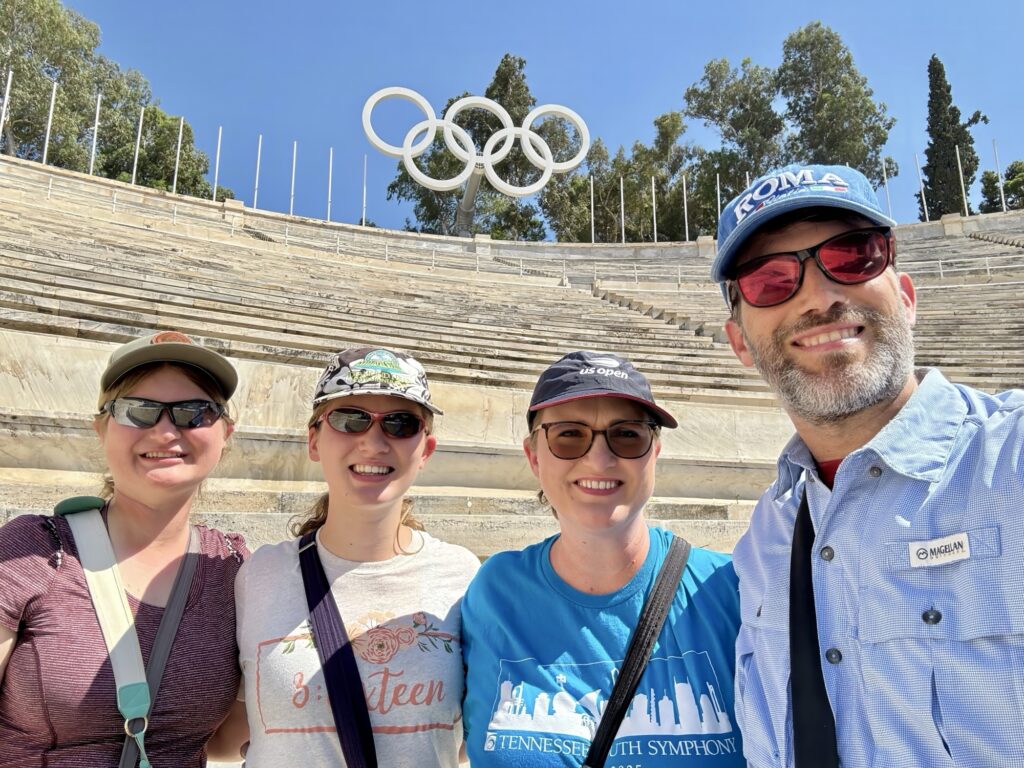
For the final full day of our epic Italy & Greece vacation, we started with alarms around 6:30 AM. Today we had scheduled for a van to pick us up at 8:00 AM for a visit to ancient Corinth, Cenchrae, and other surrounding sites. This ended up being the most jam-packed day of our trip.
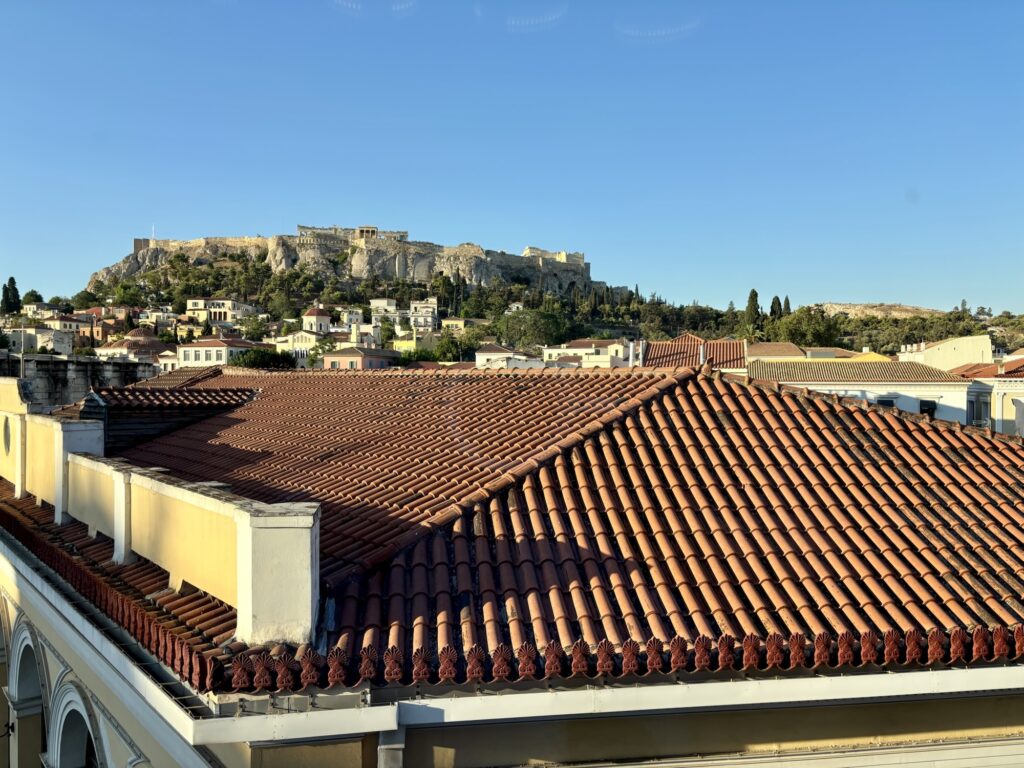
For breakfast, we headed to Monastriaki Square to a sister hotel of Hotel 360 where our included breakfast was served. The dining area had an amazing view of both the Acropolis and Mars Hill.
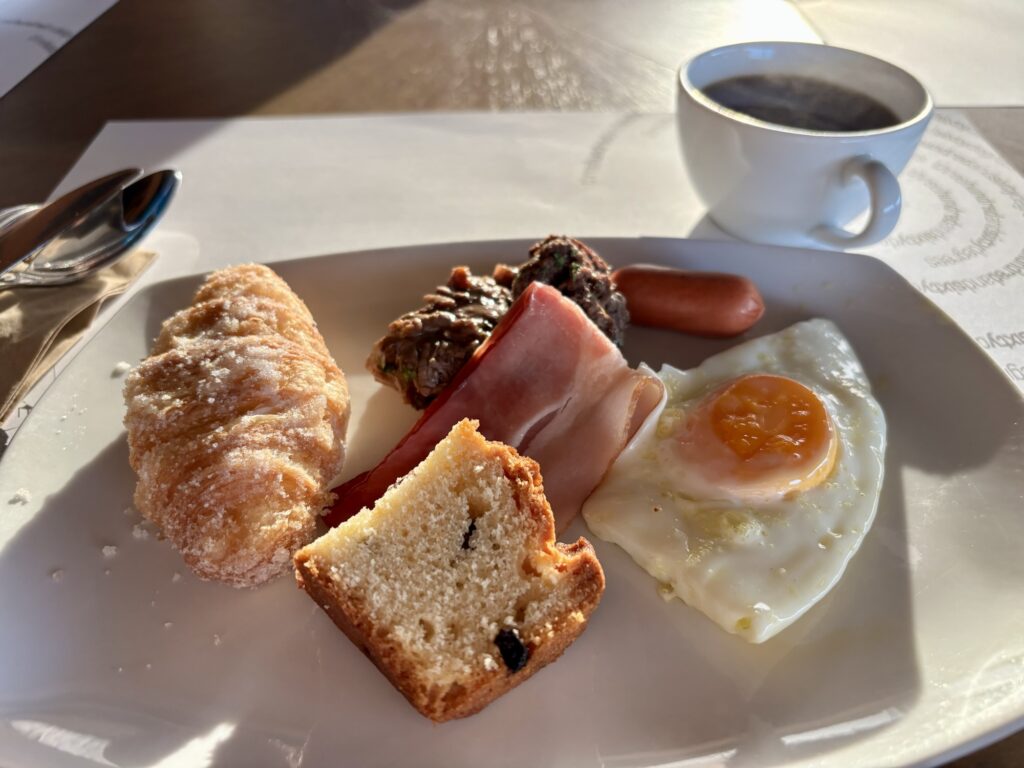
The breakfast was a buffet with eggs, various meats, and delicious pastries. We all especially liked the croissants that were filled with cream or chocolate. This was one of the best hotel breakfasts I’ve ever had.
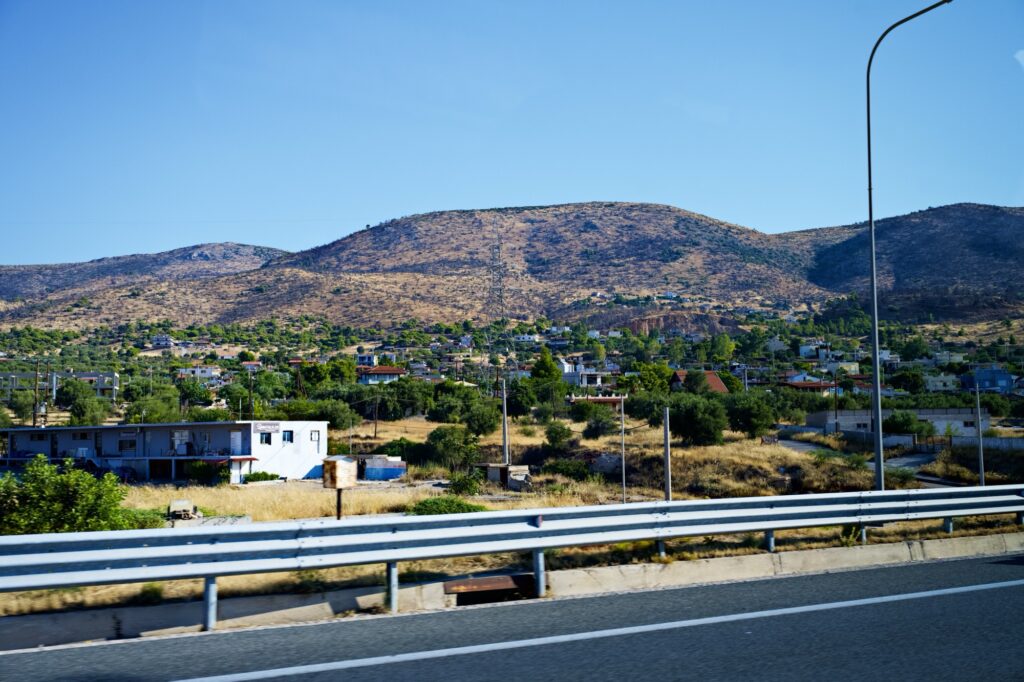
After breakfast we met our driver Nick outside our hotel to take us toward the Peloponnesus of Greece. He came in a comfortable Mercedes van that was very nice for our exploring during the first part of the day. He said that our first stop would be a little over an hour away, so we took in the beautiful countryside with lots of olive trees and rock filled mountains (some might have taken naps). We also passed by the largest commercial harbor in Greece.
Korinthos Isthmos Canal
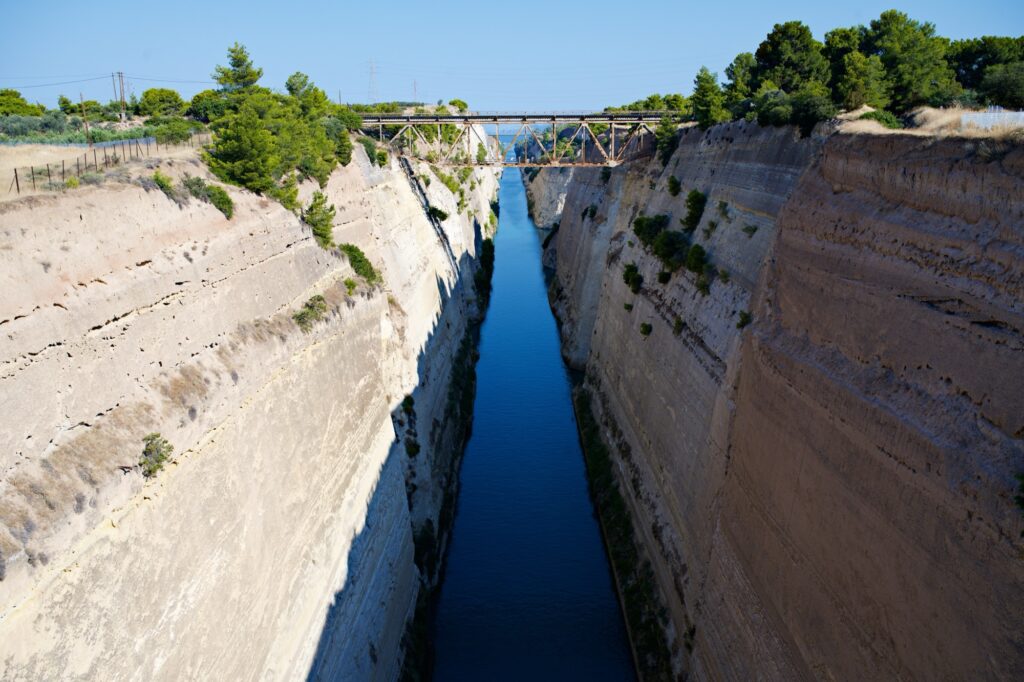
Our first stop was to see the Korinthos Isthmos Canal, which was dug between 1880 and 1890 to connect the Aegean Sea to the Ionian Sea. Nick told us that the canal is 6.5 kilometer long.
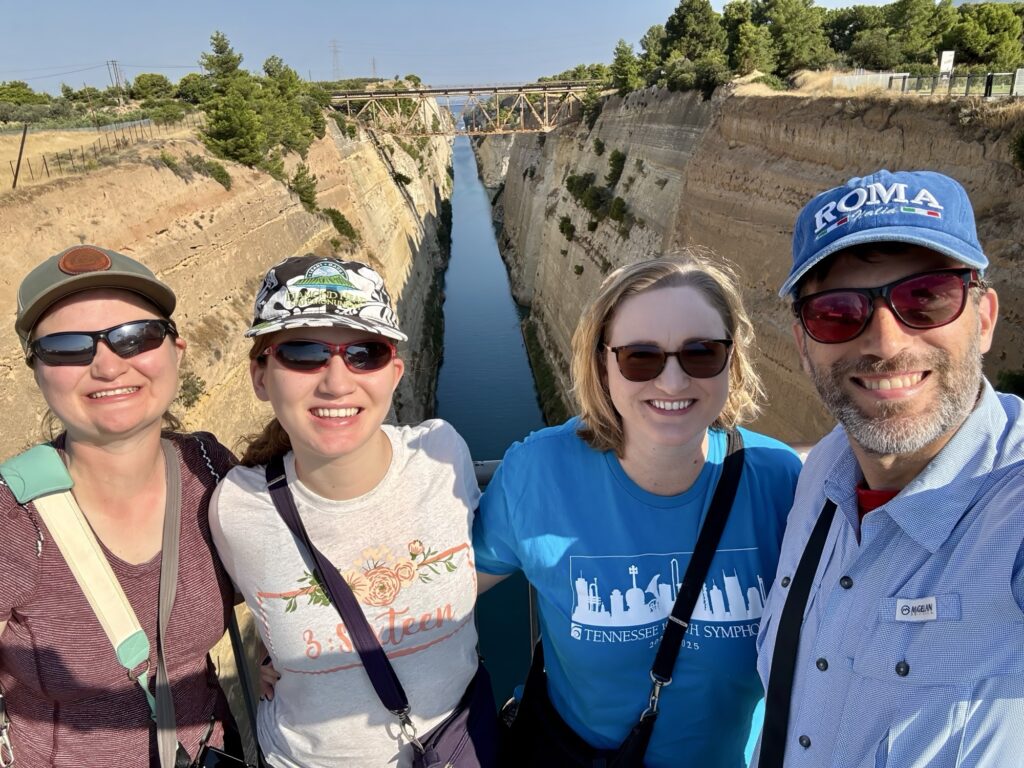
For the view, we went out on a bridge that was 70 meters above the canal. An impressive project to have been completed so long ago.
Cenchreae
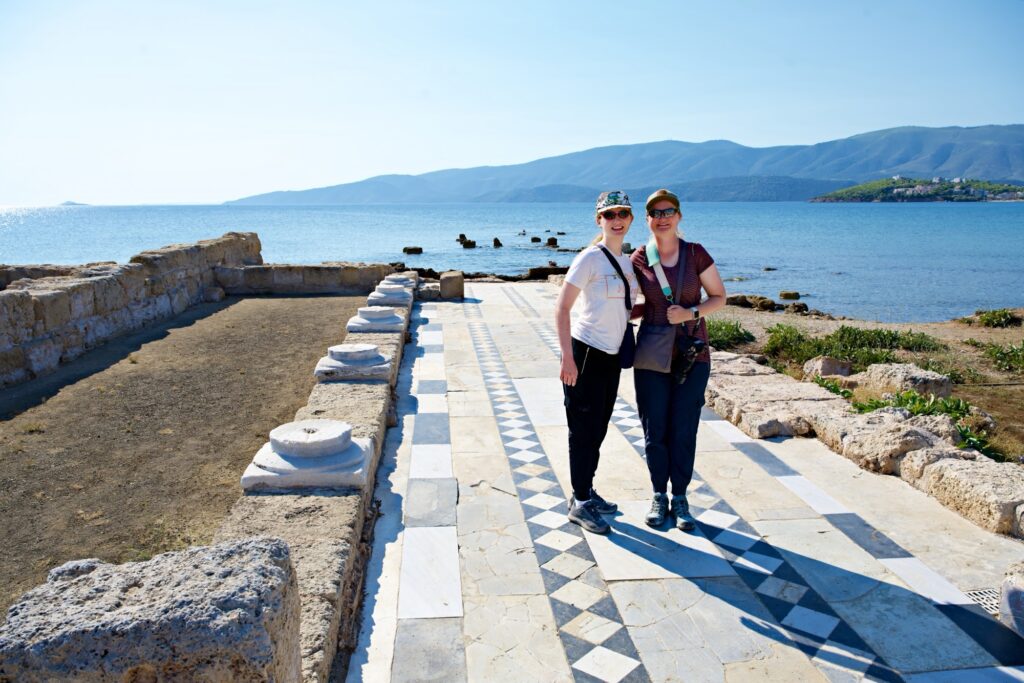
Cenchreae in the New Testament: Cenchreae is only mentioned twice in the New Testament. The first comes in Acts 18:18 as Paul is leaving Corinth after his first visit. Luke mentions that Paul “had cut his hair, for he was under a vow…” in Cenchreae. Paul was on his way back to Antioch of Syria (he would make several stops first) at the end of this second missionary journey. Cenchreae was the port city of Corinth, which almost certainly why Paul came to Cenchreae with Priscilla and Aquilla whom he had met at Corinth (more on this later). With regard to “cut[ting] his hair”, Paul had likely taken a Nazarite vow.
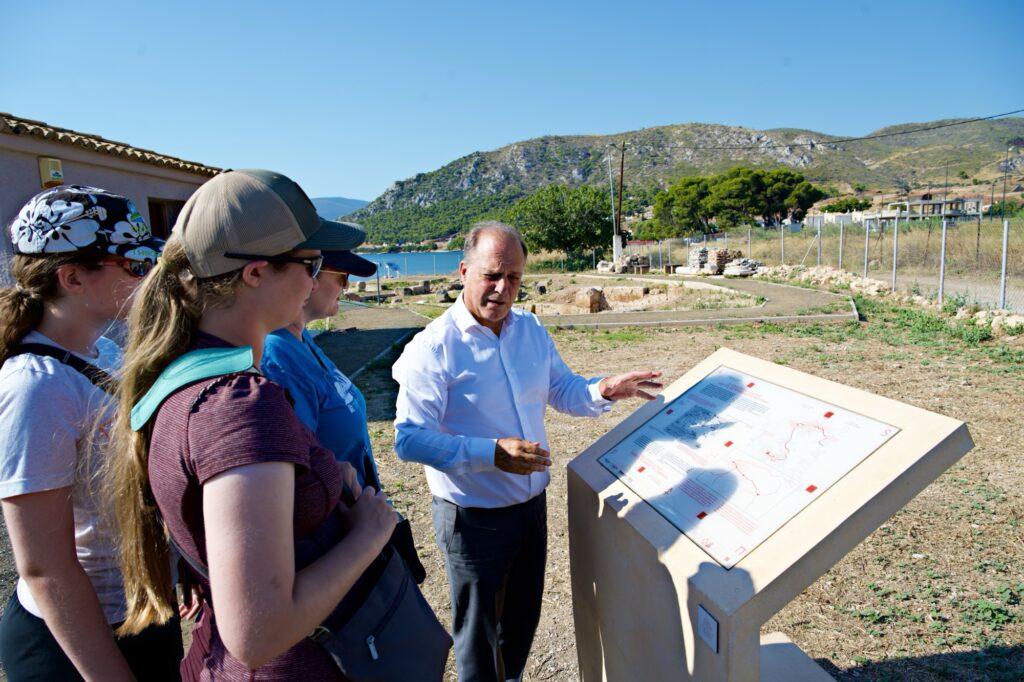
The second mention of Cenchreae is in the final chapter of Paul’s letter to the Romans. Paul likely wrote this letter from Corinth and delivered it by the hands of Phoebe (Romans 16:1-2). Paul mentions that Phoebe is “a servant of the church at Cenchreae”.
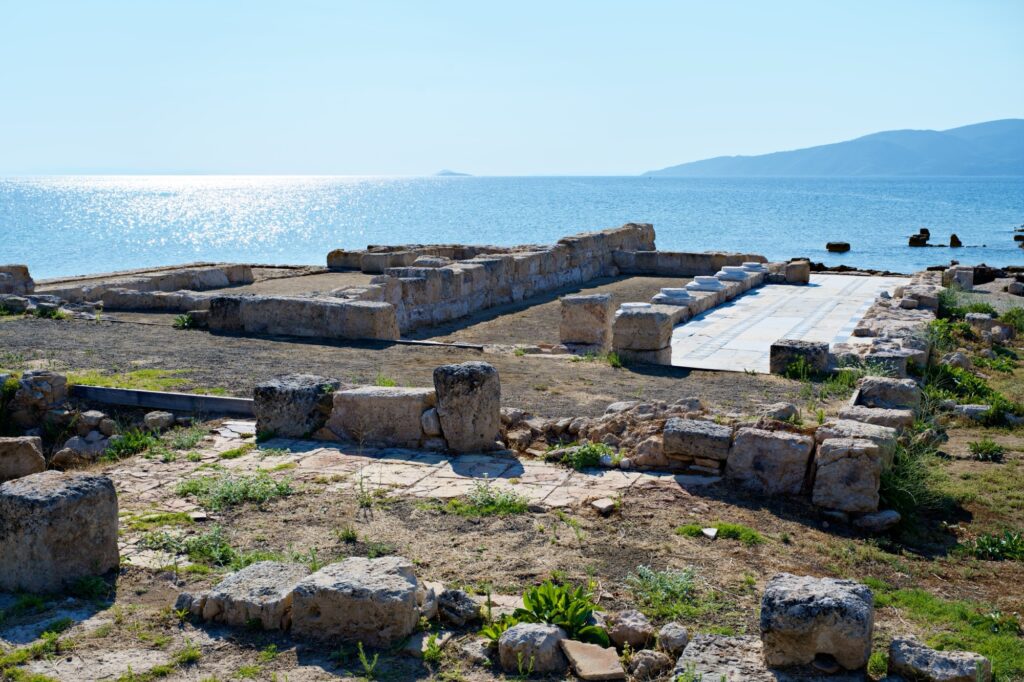
Our Visit Today: We arrived at the remains of the ancient port of Cenchreae (modern Kechries) a few minutes after leaving the Korinthos Isthmos Canal. Cenchreae is seven miles east of Corinth on the Aegean Sea. The majority of the remains of the port are now underwater in the sea, but some of the structures are still visible.
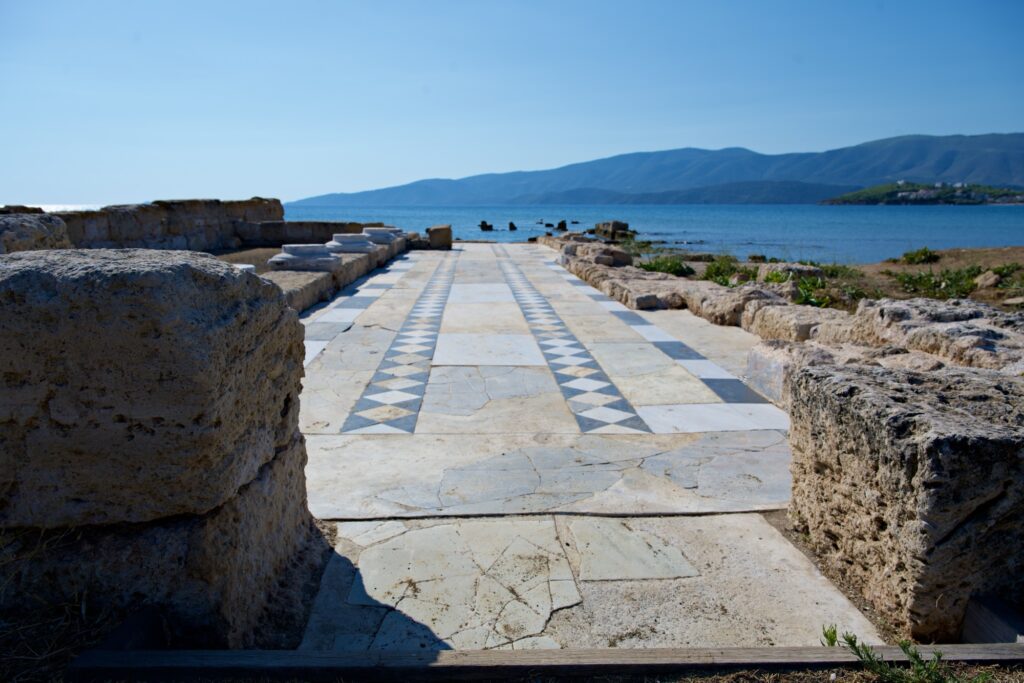
Nick joined us as we walked through this archaeological site. He pointed out a striking marble, mosaic walkway, surrounded by column bases that once formed a colonnade. This was a walkway into the ancient harbor that has been restored using the original pieces of the mosaic that have been recovered. To the left of this walkway are the remains of a temple to Isis that was later converted into a Christian basilica.
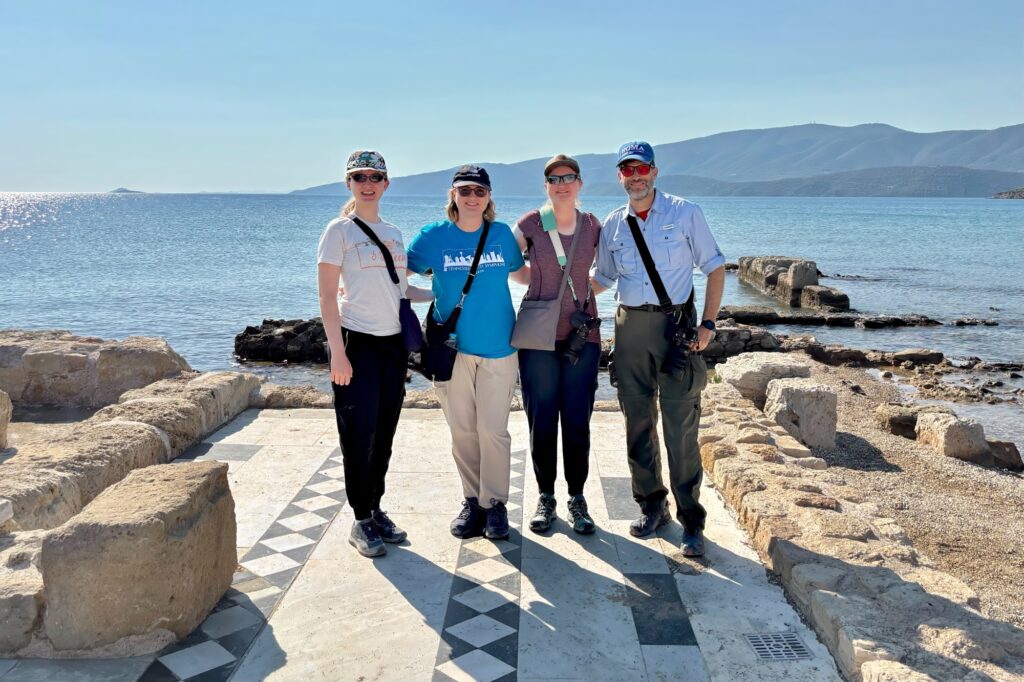
It is possible that the Apostle Paul walked on this marble, which is incredible. We know he sailed out of Cenchreae as he went to Ephesus across the Aegean Sea after leaving the port. Amazingly, we were able to walk on it ourselves. Nick was nice enough to take a picture of our family on this amazing walkway. Still walking in the footsteps of Paul!
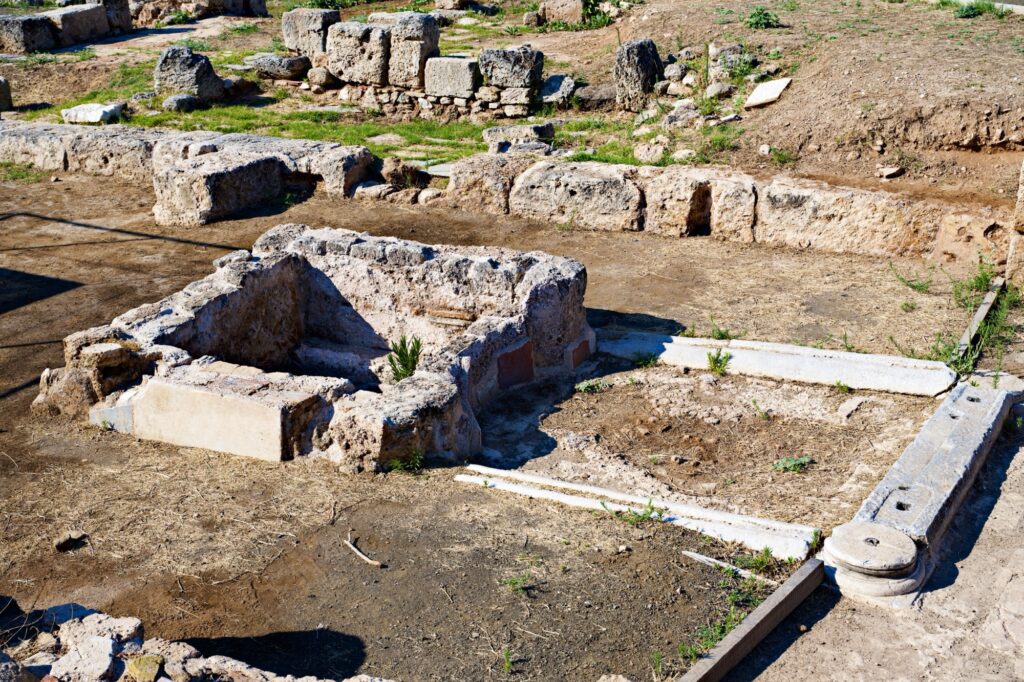
Before we left, Nick showed us a marble and stone “baptistry” that, according to tradition, was used by Paul to baptize people into Christ in Cenchreae. Obviously we have no way to know this, but I’ll admit that it did look like a baptistry, or like Jewish mikvah that are found all over Israel.
Greek Orthodox Church dedicated to St. Paul
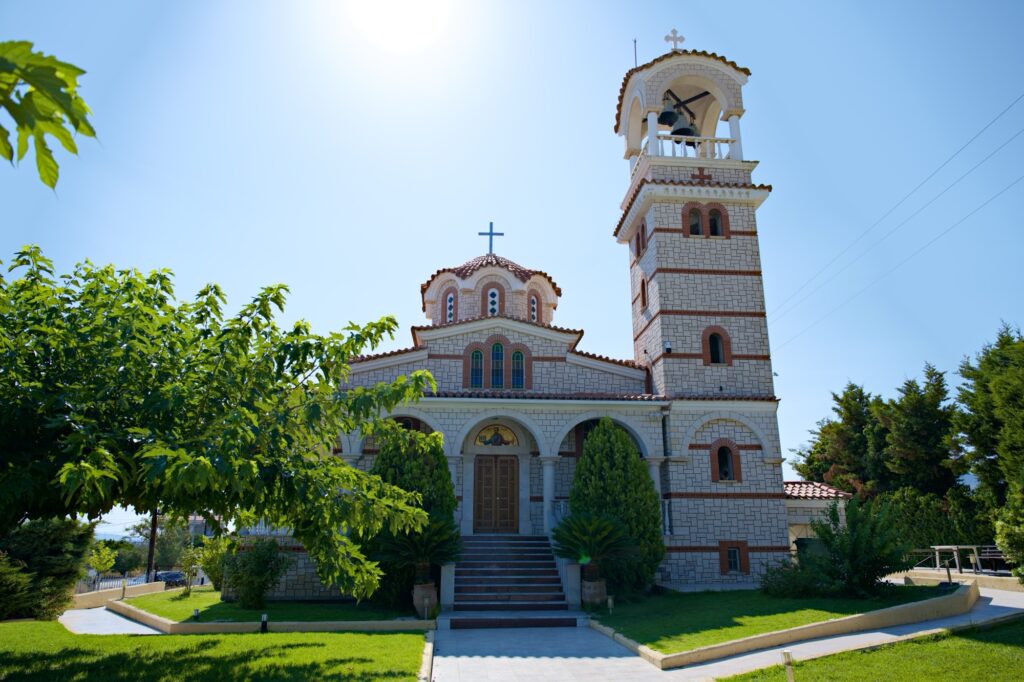
Our next stop was a brief visit to a beautiful Greek Orthodox church building near Ancient Corinth, at the base of the Acropolis of Corinth. The Acropolis of Corinth (Acrocorinth) is a 650 meter high mountain with a castle on top (more on this later). There is a tradition that Paul preached in the place where the church building was constructed while evangelizing in Corinth.
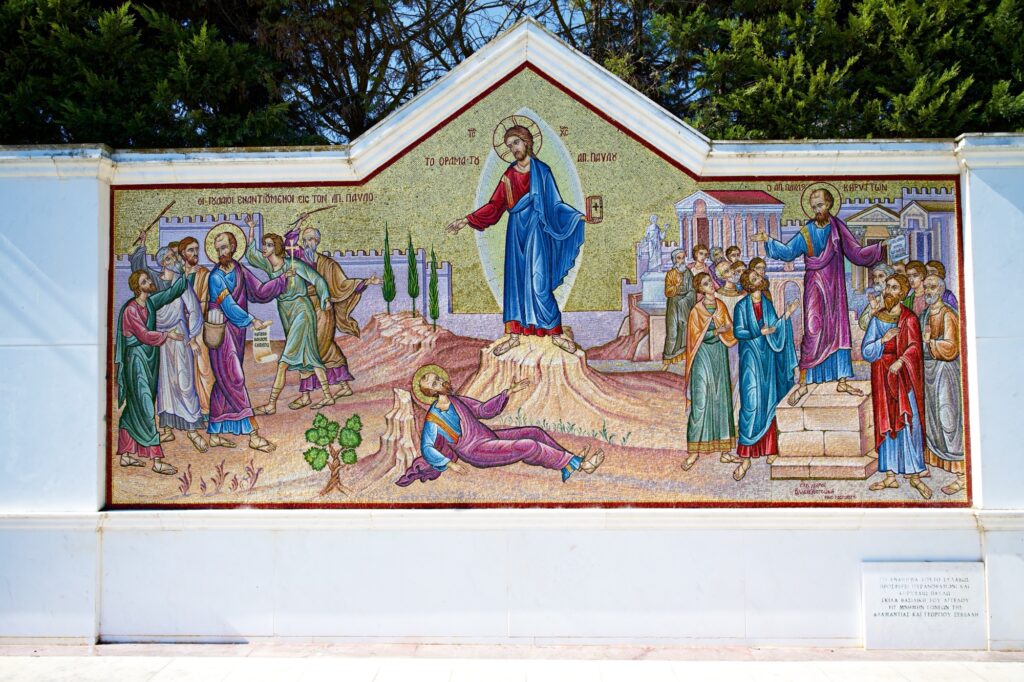
The church building was built in 1999 and is beside mosaic work of art from 1976. The mosaic is made of painted marble stone, and is called the “Vision of St. Paul”. In the center it depicts Jesus giving power to Paul. On the left it shows the Jews in Corinth who didn’t believe. On the right it shows Paul preaching with the power of Christ to the people of Corinth.
Greek Orthodox Church dedicated to Virgin Mary
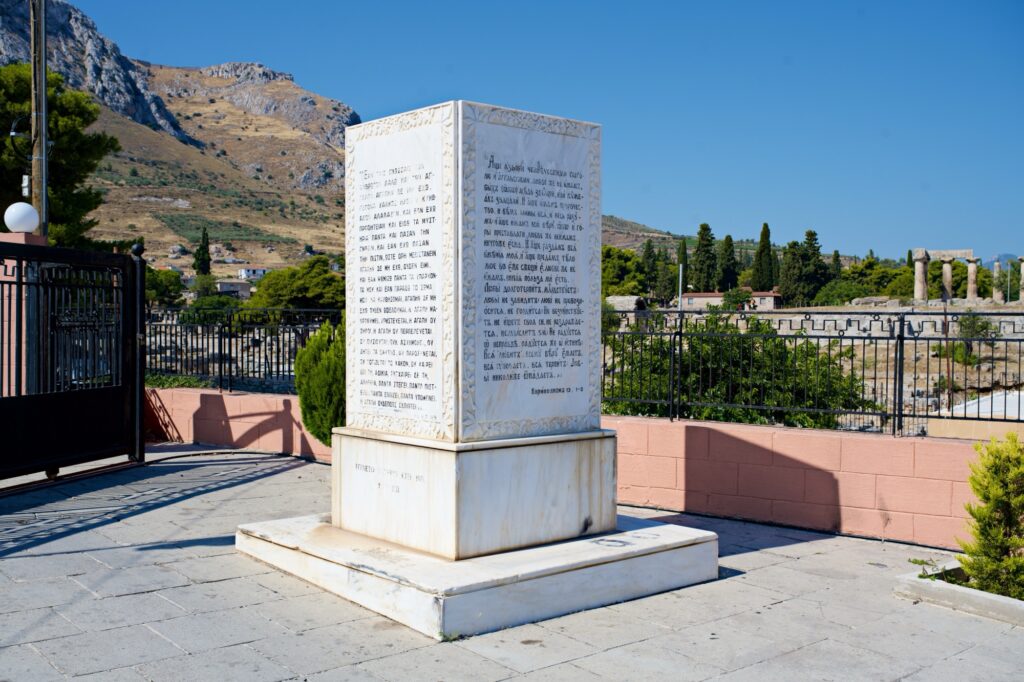
Directly beside the ruins of Ancient Corinth, we made a brief stop at another Greek Orthodox church building dedicated to the Virgin Mary. The reason for this stop was to see a marble monument with part of 1 Corinthians 13 written in English, French, Arabic, and Greek.
Ancient Corinth
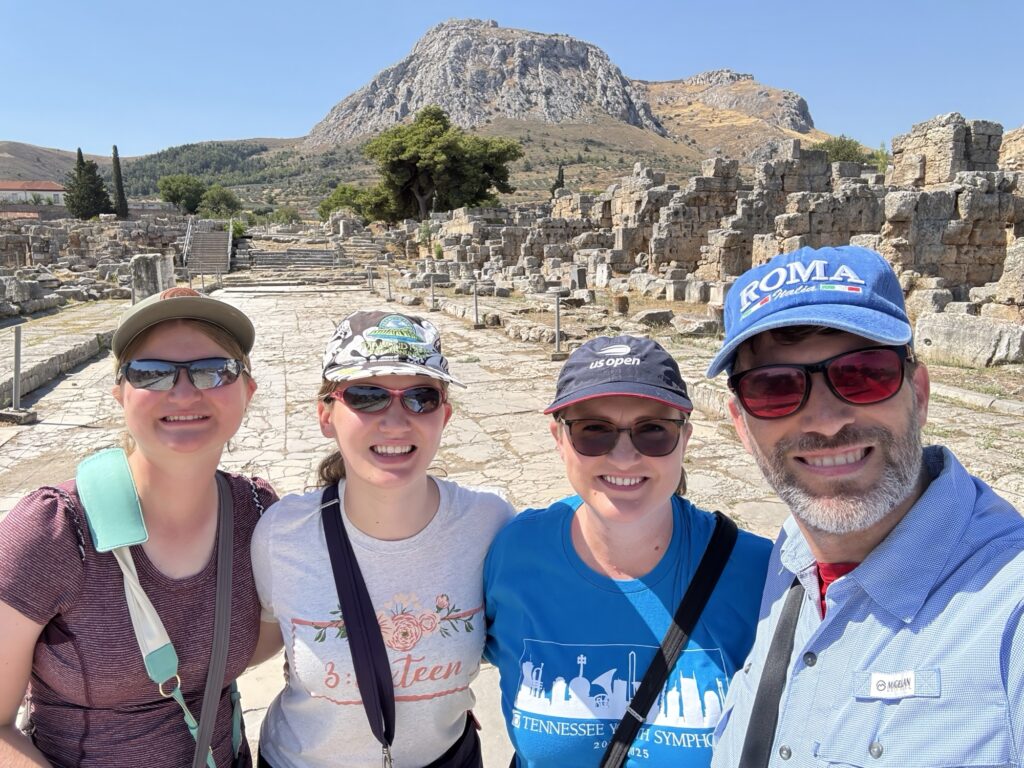
The Apostle Paul in Corinth: The Apostle Paul’s first visit to Corinth is recorded by Luke in Acts 18:1-18, during Paul’s second missionary journey. He came to Corinth after leaving Athens (1). Upon arrival in Corinth, Paul met the Jewish couple Priscilla and Aquila, who had been forced to leave Rome because of an edict by Claudius (2). They ended up working together as tentmakers (3). As was Paul’s standard procedure, he started evangelizing Corinth by teaching in the synagogue every Sabbath (4). Silas and Timothy met up with Paul in Corinth while Paul was busy preaching to the Jews (5). When the Jews began to “oppose and revile” Paul, he shook out his garments and said “Your blood be on your own heads! I am innocent. From now on I will go to the Gentiles…” (6). From there he went to the house of a believer named Titius Justus, “next door to the synagogue” (7).
Crispus, the rule of the synagogue, became a believer along with his entire household, and God promised Paul in a vision to keep preaching and He would protect him (8-10). Because of this, Paul stayed in Corinth for 18 months preaching and teaching the word of God (11).
The Jews eventually brought a united attack agains Paul and dragged him before a tribunal led by Gallio, who was the proconsul of Achaia (12-13). On a side note, Corinth became the capital of the Roman province of Achaia in 27 BC. Gallio refused to hear any of their charges (14-16). After all of this, Paul stayed “many days longer” before leaving for Cenchreae (18).
Paul spent an additional three months in Corinth during his third missionary journey (Acts 20:2-3). At least part of the reason for his visit was to collect contributions that Corinth had been making for poor christians in Jerusalem (1 Corinthians 16:1-3; 2 Corinthians 8 & 9).
Paul’s Letters to the Corinthians: Paul wrote two letters to the church in Corinth that are in the New Testament. These epistles address a number of issues facing the church, provide instructions and exhortations, and gives a defense against those who would challenge his authority as an Apostle of Jesus Christ. Perhaps the most famous section of these letters is the beautiful chapter on love in 1 Corinthians 13.
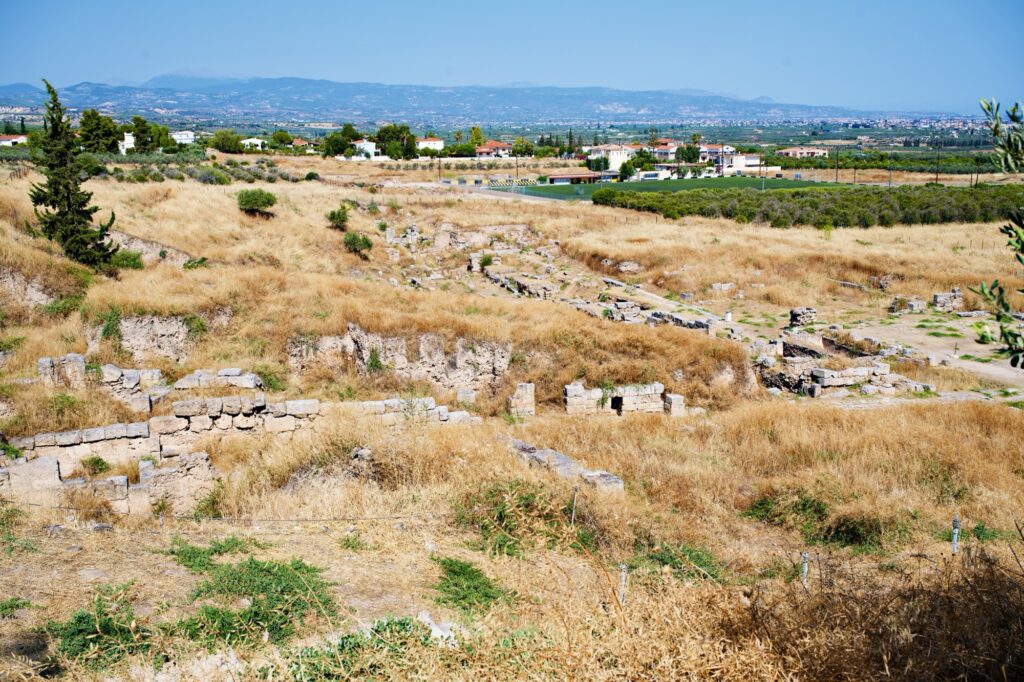
Our Visit Today: At Ancient Corinth, Nick first took us to a part of the site that is outside of the area accessible by the public. From the fence we could see the shape of the theatre of Corinth that has yet to be excavated. From there, Nick took us over to the main entrance gate where we had an hour to explore the rest of the ancient city on our own.
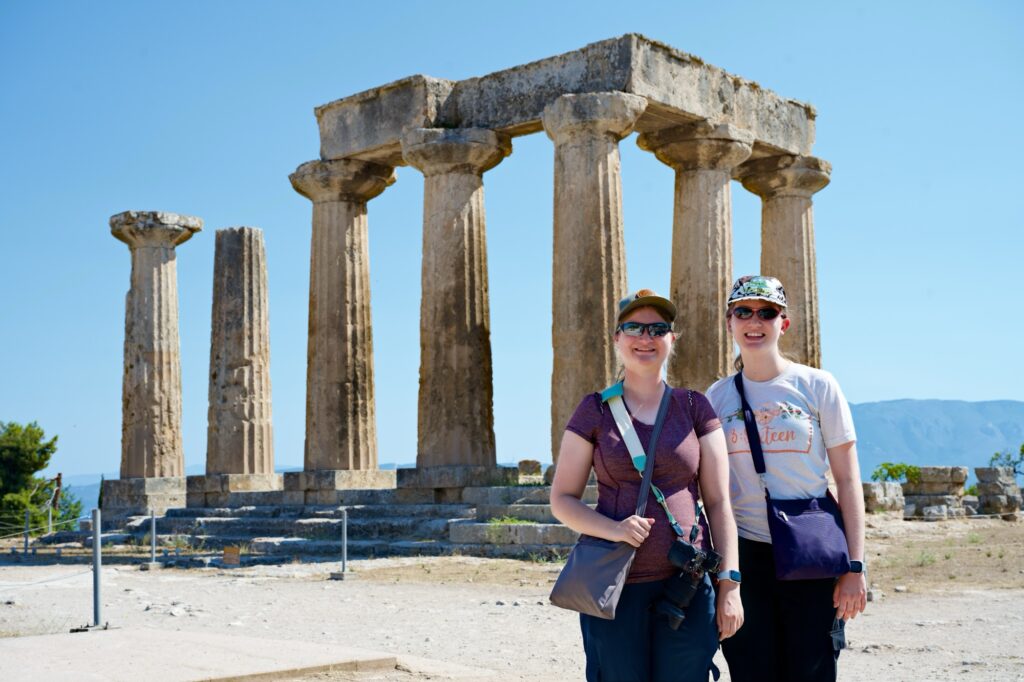
After purchasing tickets, we began to work our way through the ruins. The city of Corinth dates all the way back to the 10th century BC, and continued to be a major city through the time of the Roman Empire.
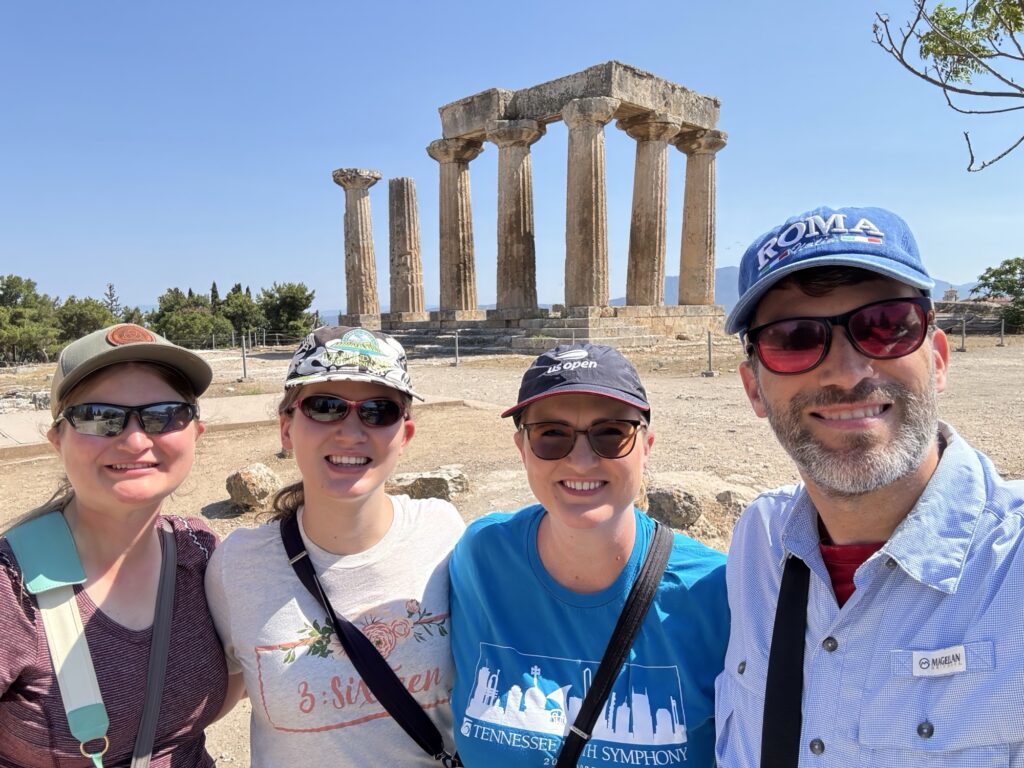
The most striking building in Ancient Corinth is the Temple of Apollo that dates back to the sixth century BC (archaic period).
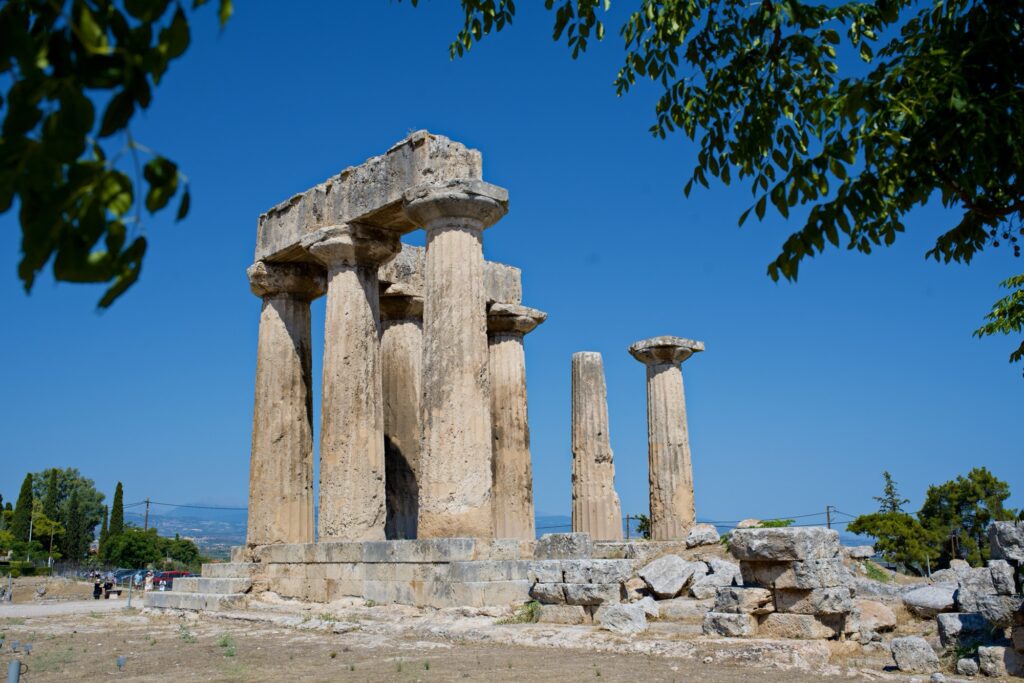
There are seven massive columns remaining from what would have been the back of the structure. The footings of the temple show that it originally had two rows of columns.
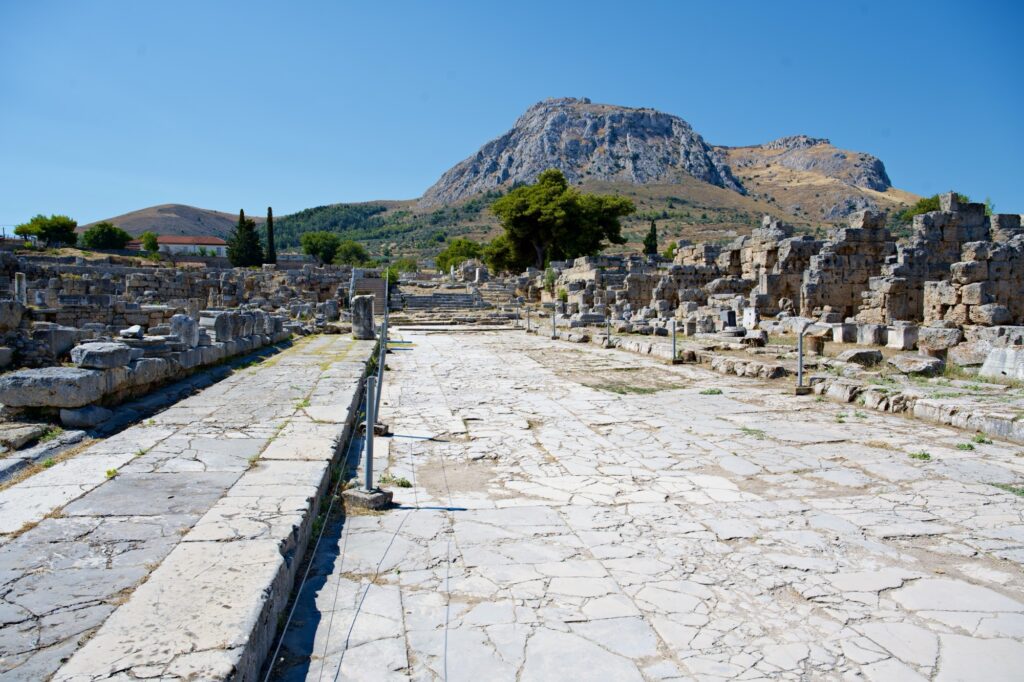
On the opposite corner of the site from the Temple of Apollo is Lechaion Road, which was the main entry into Corinth during Roman times. This marble road connected the harbor of Corinth to the Roman Forum in the middle of the city.
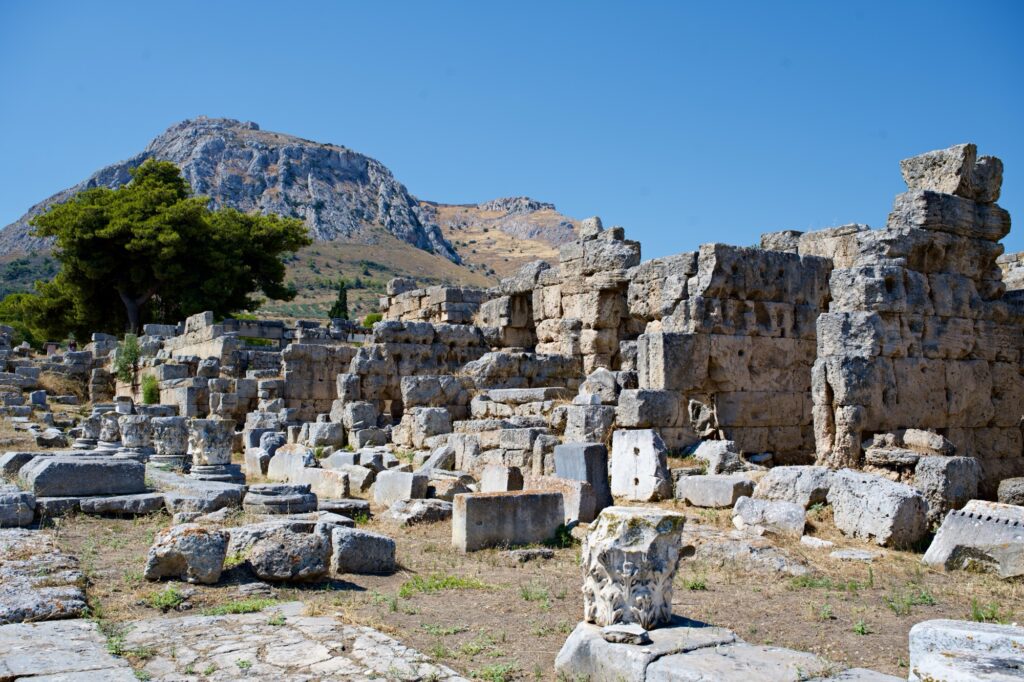
Walking into the city, they have uncovered at least 16 small shops that were on the right side of the road.
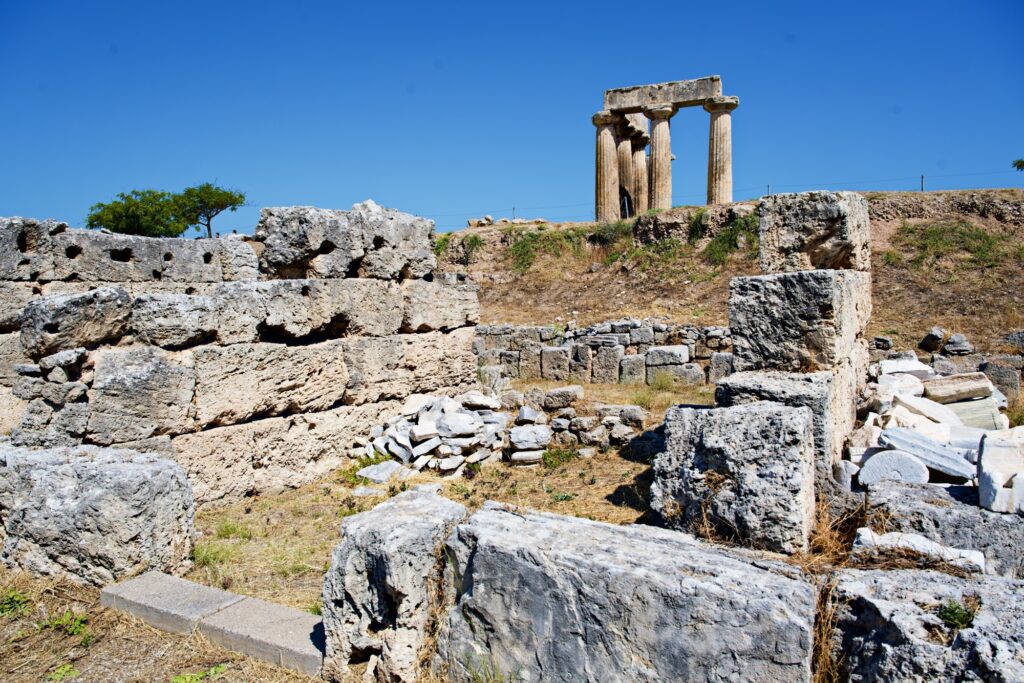
These shops continued to what is known as the “northern shops” above the road and to the north.
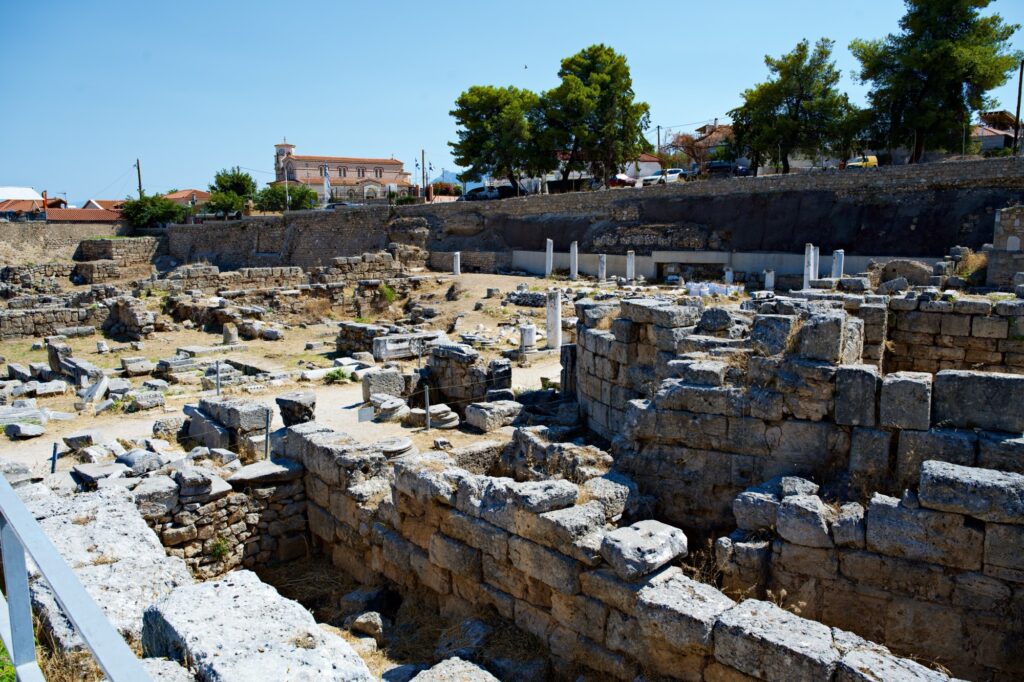
On part of the left side of the street was a colonnade for shops that had an open courtyard. Not only do we know that Paul spent at least 18 months in Corinth (Acts 18:11), but he also worked there as a tentmaker with Priscilla and Acquilla (Acts 18:2-3). It is entirely possible that Paul worked out of one of these excavated shops we saw today.

The Lechaion Road led up to the Propylaia, which was the main gate to the Roman Forum. We spent a good bit of our time walking up and down this marble road and taking in that Paul had almost certainly walked through here, and maybe worked out of the shops, while living in Corinth.

Our next stop was the Roman Forum (like a public square) and the Bema (high place), which was also known as the Rostra. The Rostra would have been a venue for public ceremonies, and there is speculation that maybe this Bema was the place where Gallio would have stood when Paul was brought before the tribunal by the Jews (Acts 18:12-15). Pretty cool to think about.
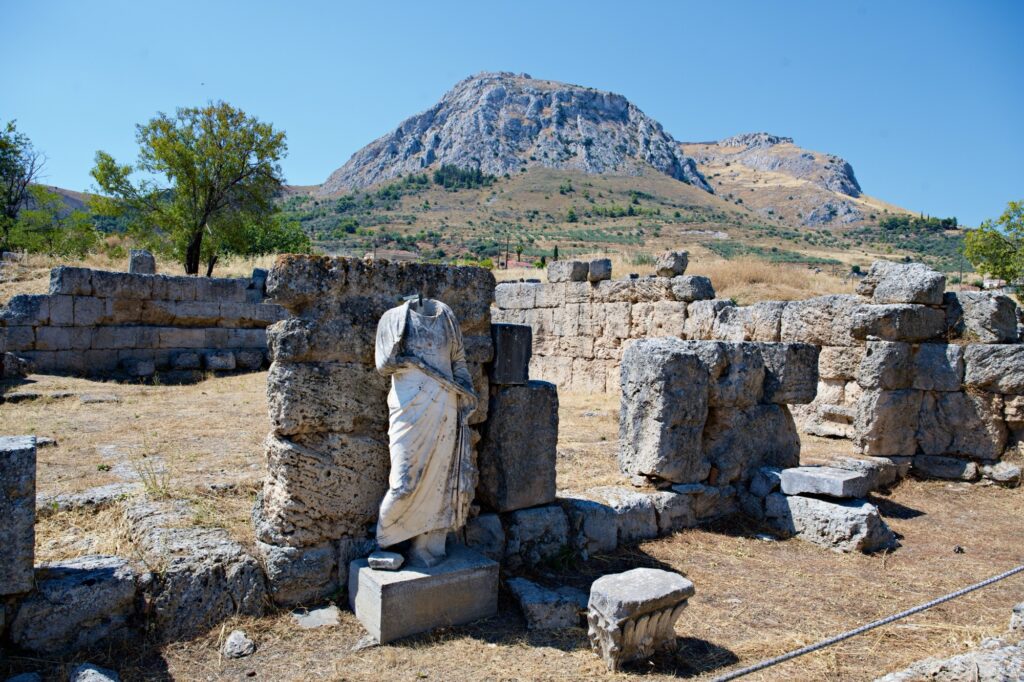
One of the final things we saw were the ruins of the western shops and the southern shops, which were another series of shops in Ancient Corinth.
Before leaving Ancient Corinth, we briefly walked through the on-site museum and saw some of the items that have been recovered from the city. This included:
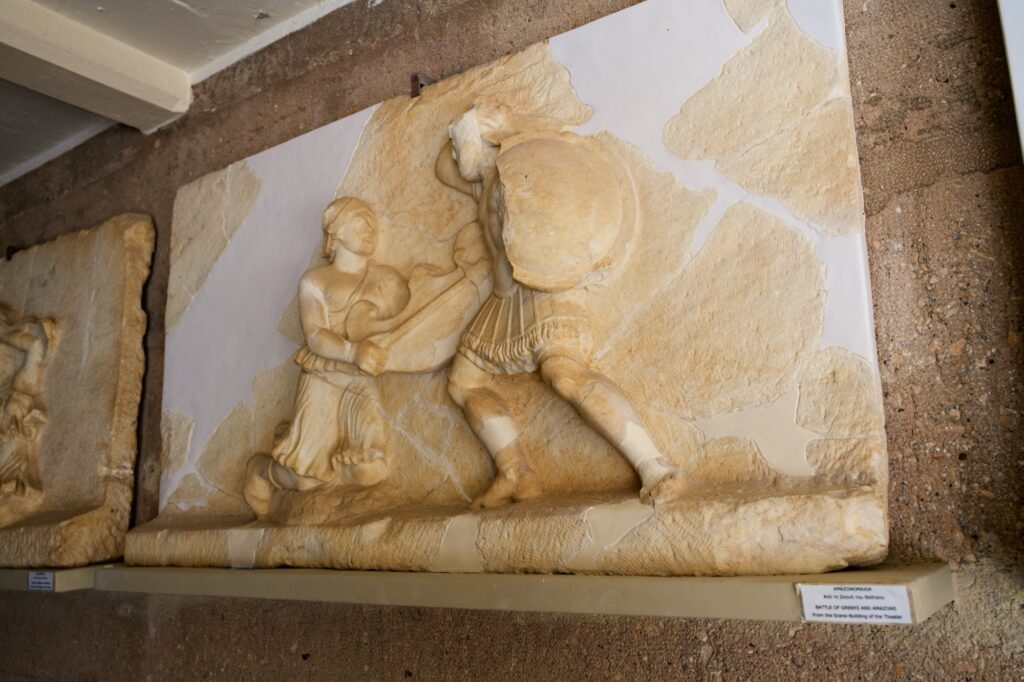
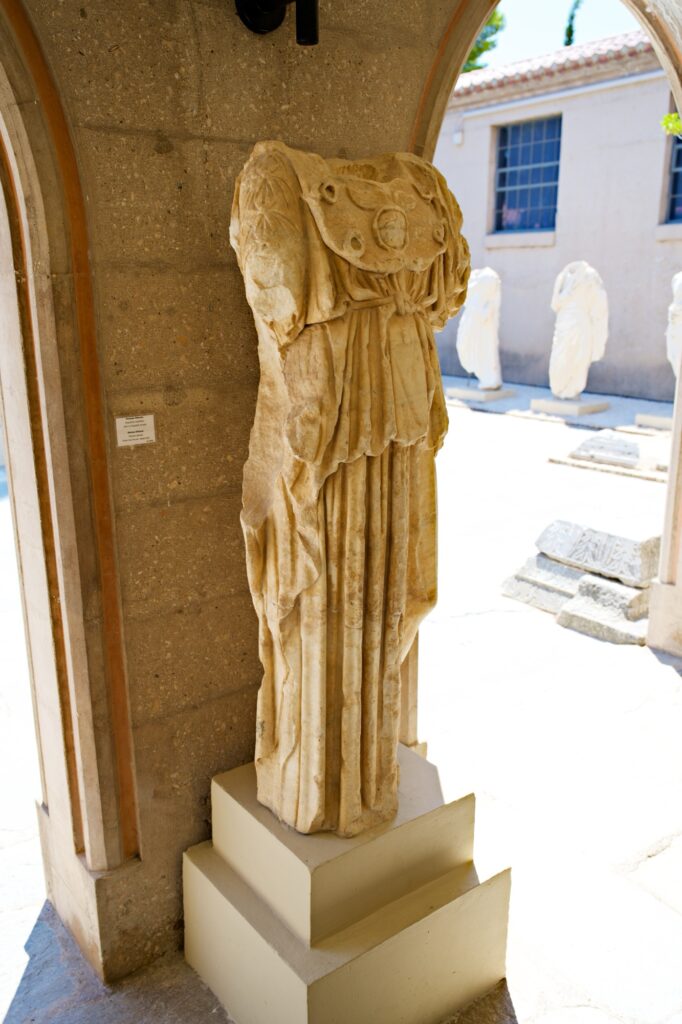
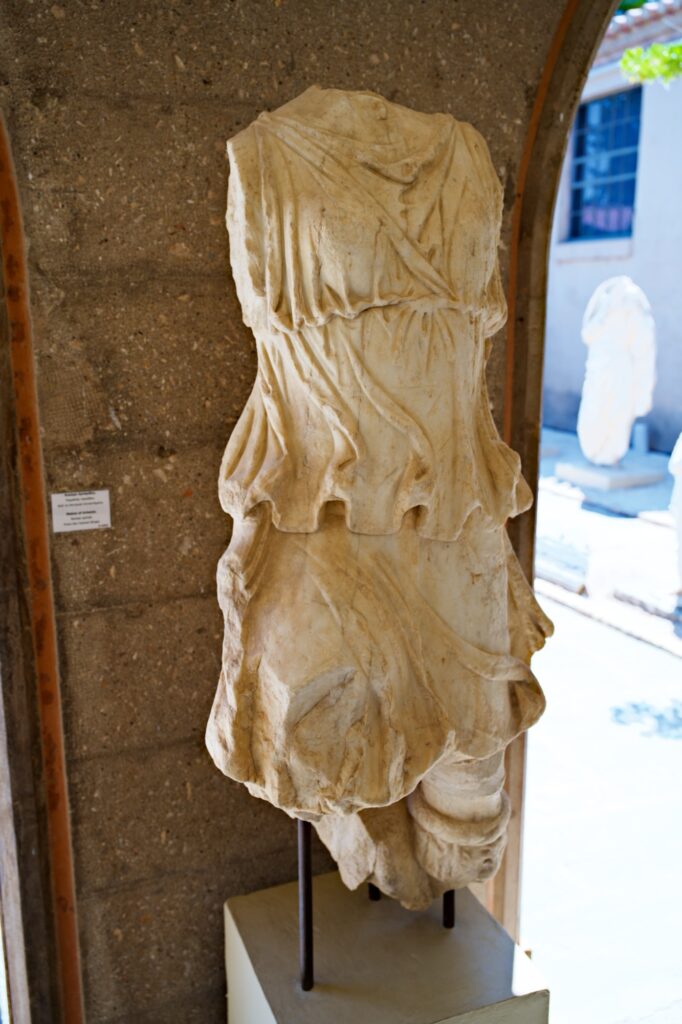
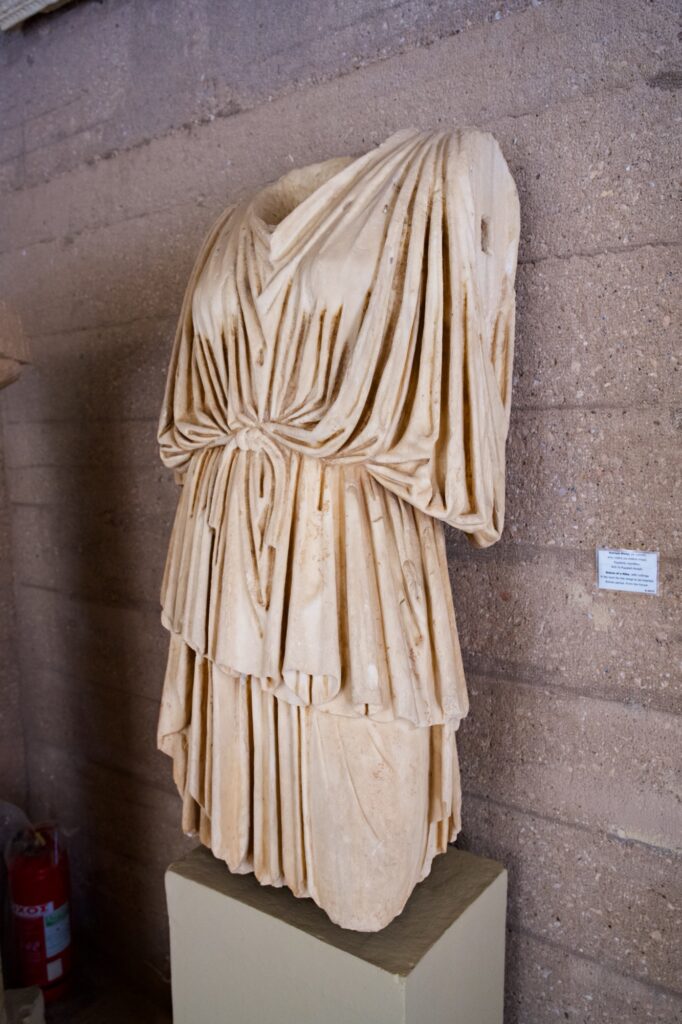
Acrocorinth
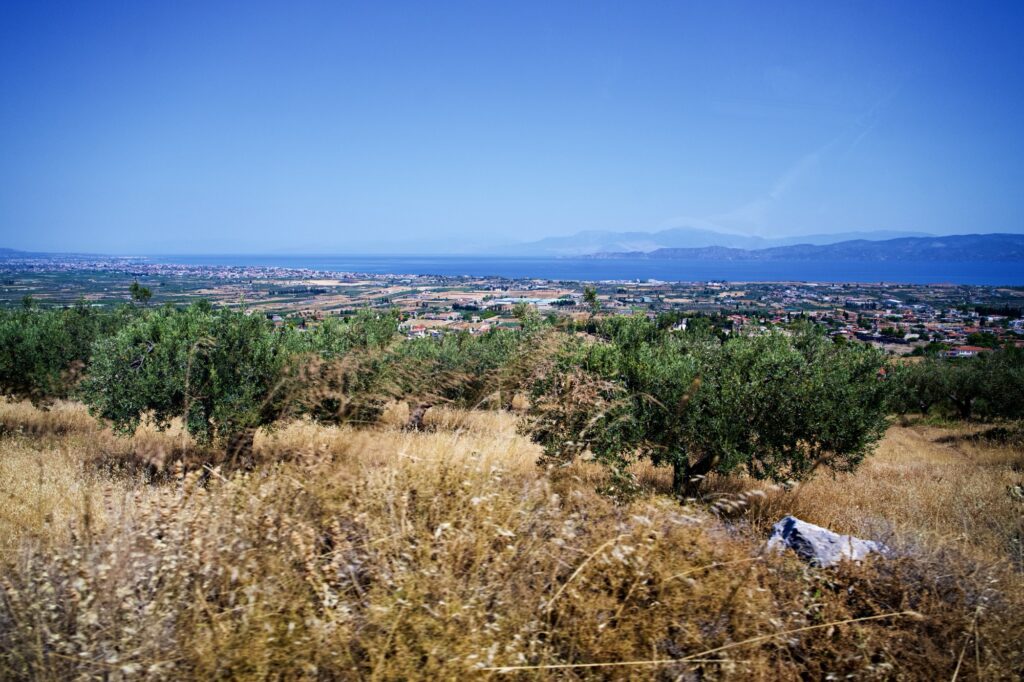
Once we left Ancient Corinth, we again boarded the van, and Nick began to drive us up to the top of the Acrocorinth. Along the way we saw lots of olive trees, and I asked Nick about them. His comment was that there were “too many” with a laugh. He said that olives and olive oil were the top agricultural products of this area.

It was a significant climb in the van as my ears started popping. As I said above, the Acrocorinth is a 650 meter high granite mountain with a castle on top. The castle is the largest in Greece. Near the top of the Acrocorinth, Nick parked the van and gave us another hour to explore the castle. This was quite an adventure as the streets of this castle are very, very slick, and very, very steep. Olivia was quite a trooper with her fear of heights.
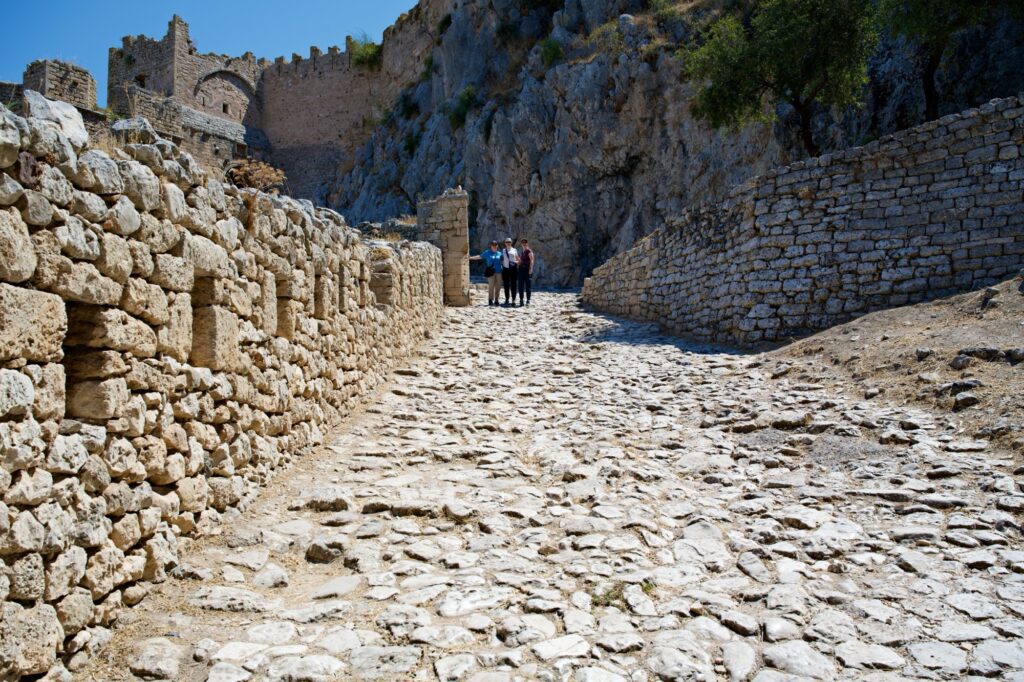
The beginnings of this castle date back to the 7th century BC. It was further fortified in 4 century BC and demolished by the Roman’s in 146 BC. Most of the castle that is standing today comes from the Byzantine period (ninth to 12th century AD. It was further modernized by the Turks and the Venetians in later centuries.
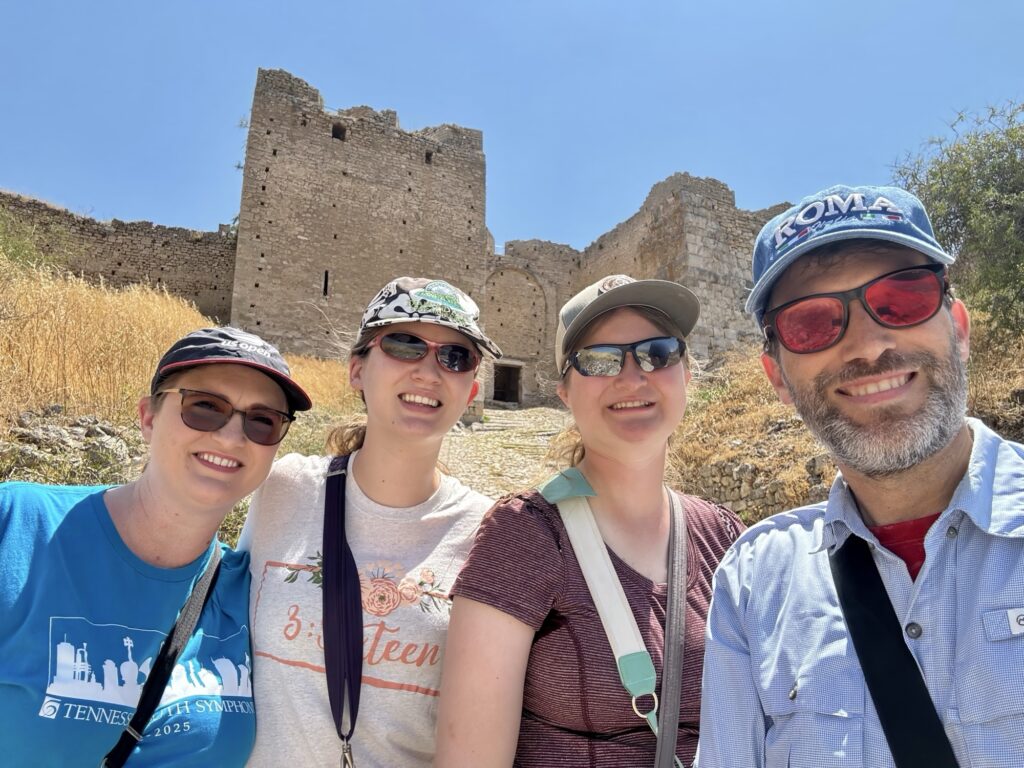
The climb up through the streets and towers was slow but really cool. This fortress is huge. Nick had warned us to not try climbing all the way to the top as it was 1 1/2 hours each way. We made just past the “third gate”, which was massive.
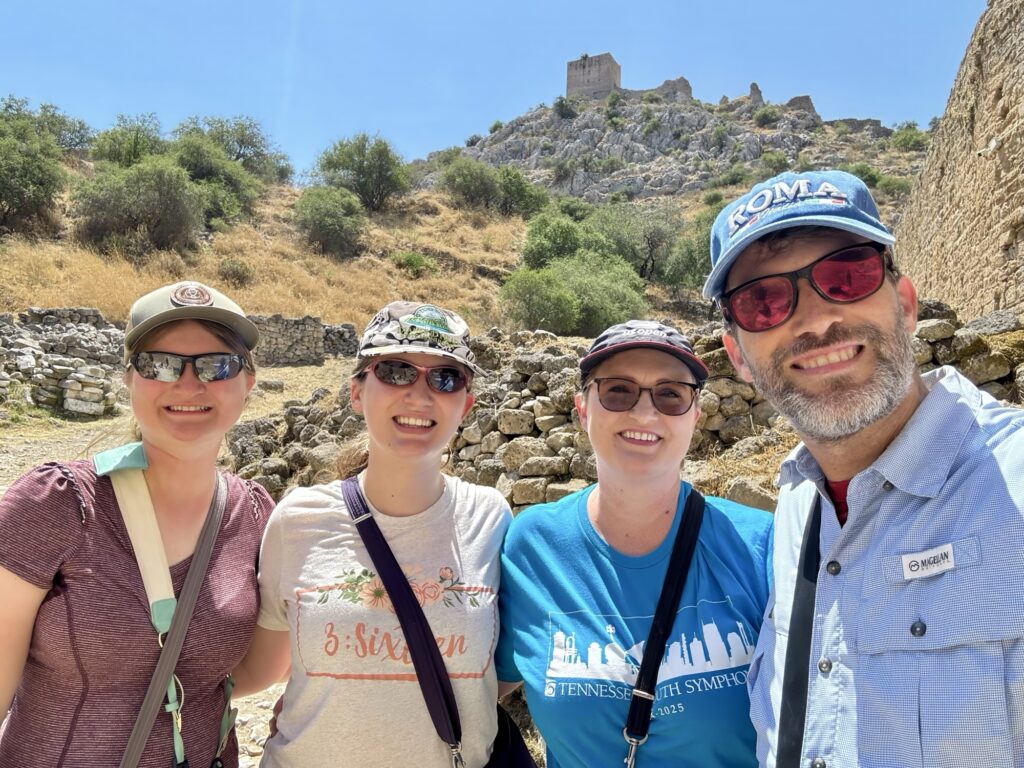
From the other side of this tower, we could see all the way to the top and it was a long way!
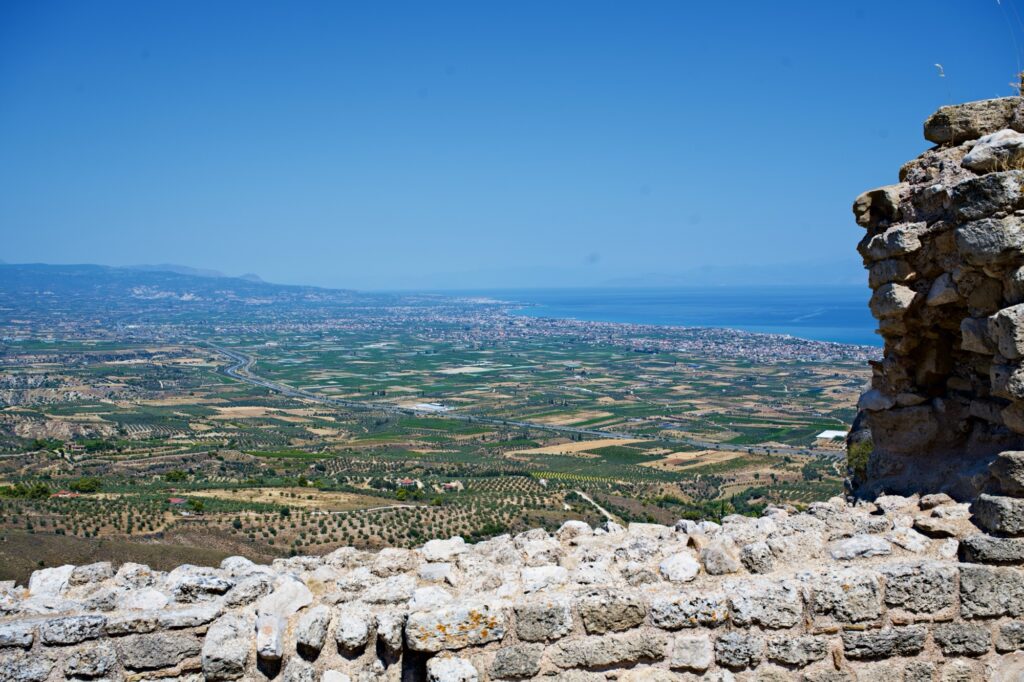
After going as high as we could, we then started to slowly descend, which was more difficult than the climb due to the slick rocks. On a side note, the views of the Ionian Sea from the Acrocorinth were amazing.
Lunch
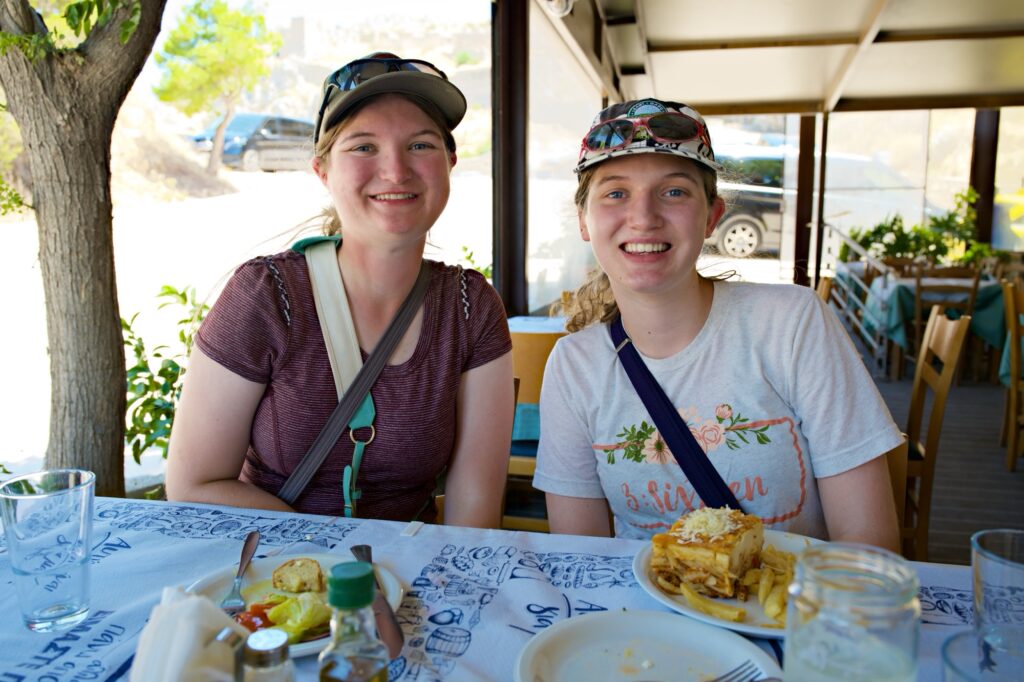
Once we were back down to the parking area, we had some lunch at a nearby restaurant called Castro, which had incredible views in all directions.
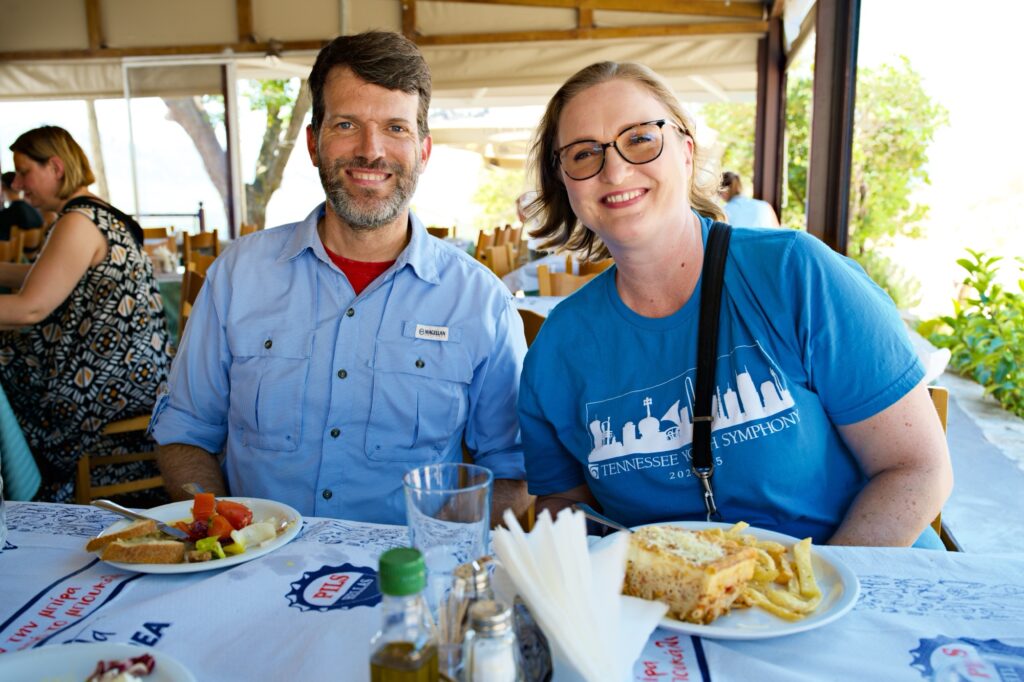
We started with a greek salad and then Kate and I had pork souvlaki, and Olivia and Sara had pastitsio. It was all delicious. Sara and Olivia also had some greek lemonade. Olivia gave me a sip of hers, and it was amazing.
After lunch, we got back in the van with Nick for our ride back to Athens. It was pretty quiet as most of Team Agee took a nap. Nick dropped us off back at 360 Hotel around 2:30 PM and we went to the room for a few minutes to regroup, re-sunscreen, and fill-up our water bottles.
Panatheniac Stadium
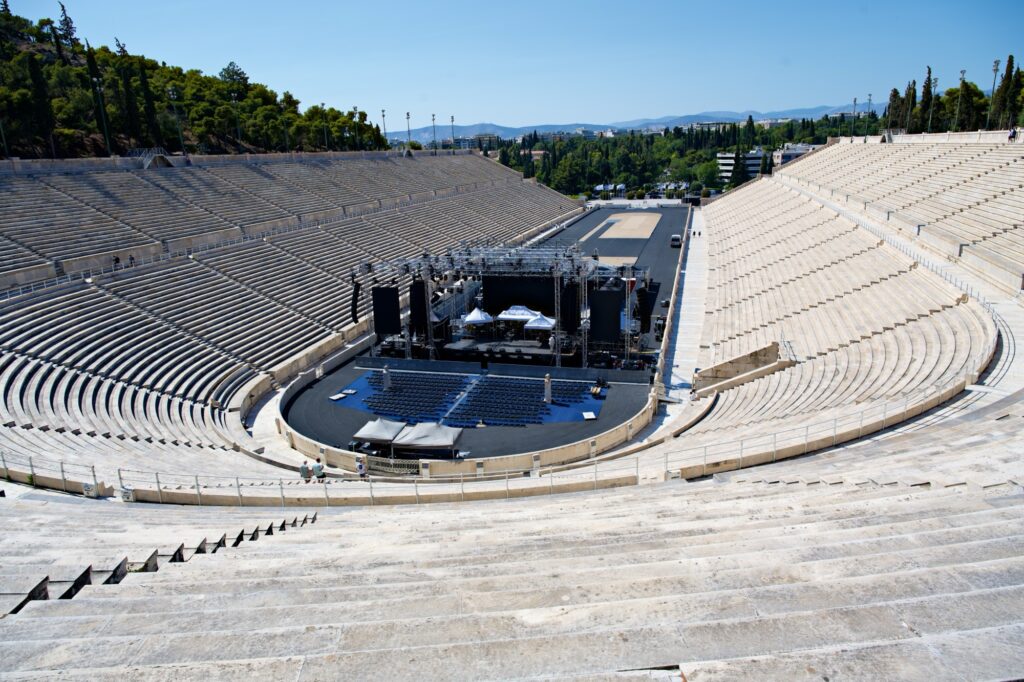
Around 3:00 PM we were back out on the streets of Athens walking toward the Panatheniac Stadium. GPS said it was the same amount of time to walk as it was to take the metro, so we decided to walk and see what we could see.
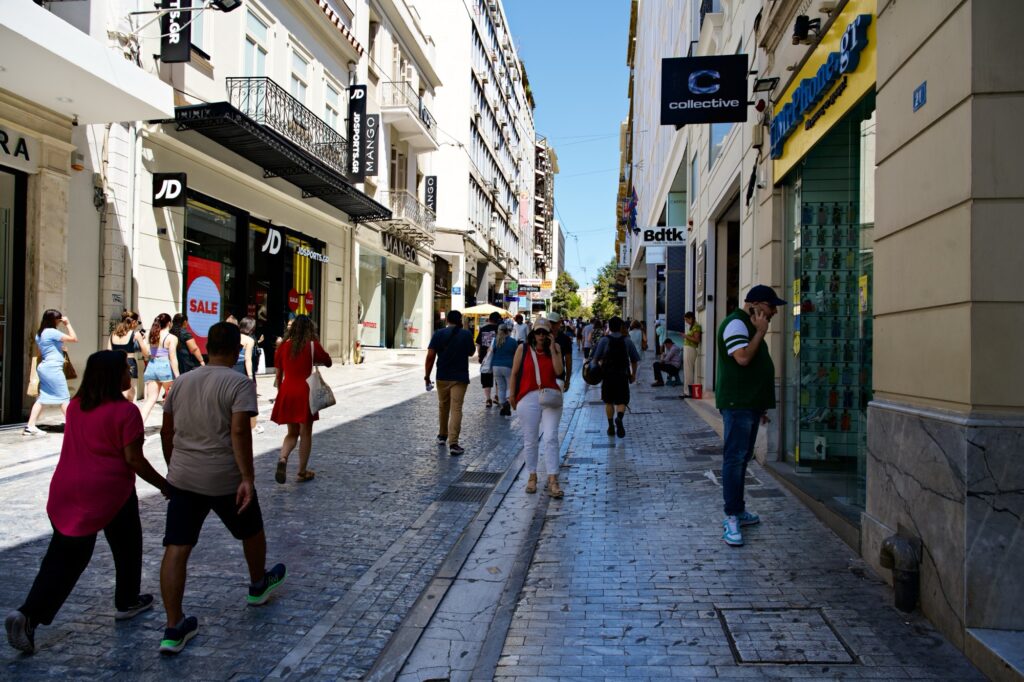
We stared by walking up Ermou Street toward Syntagama Square. This street seemed to be like 5th Avenue in NYC or Michigan Avenue in Chicago with LOTS of high end shops.
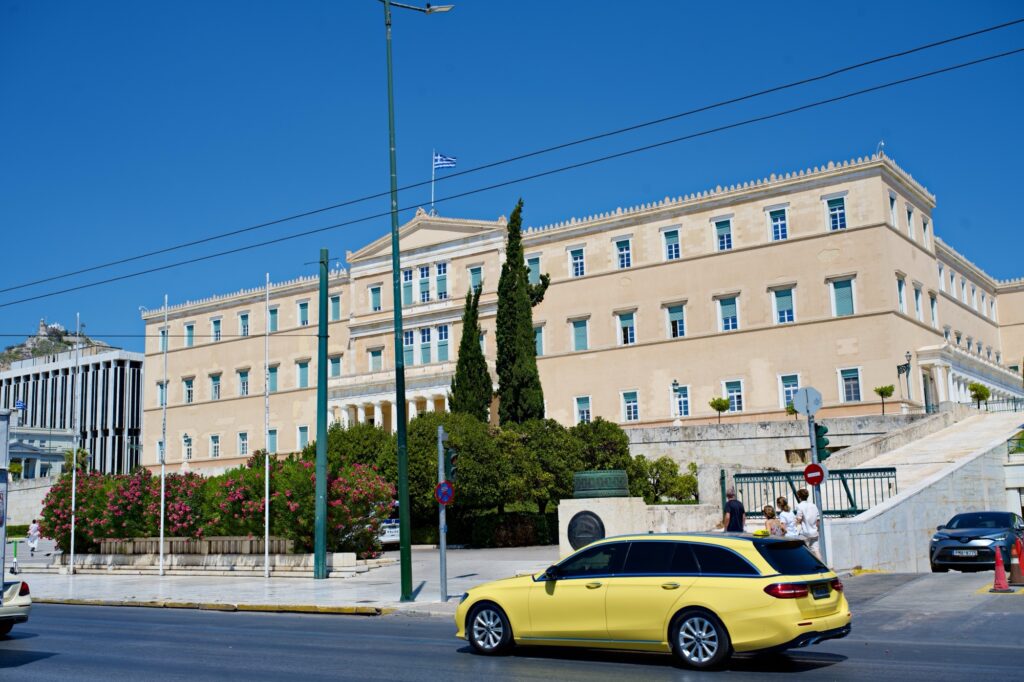
We walked to the far end of Syntagama Square and quickly saw the Parliament building before entering in the National Gardens.

In the National Gardens, we immediately saw a beautiful solar clock (i.e. sun dial). Walking through the National Gardens was absolutely beautiful and reminded us of Central Park in NYC.
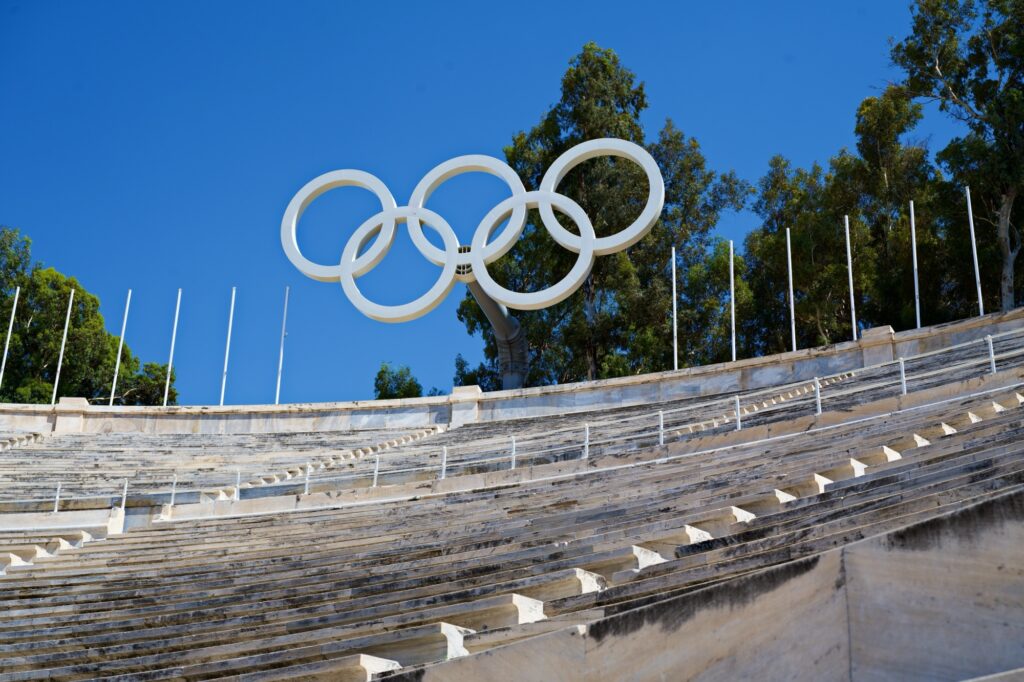
Once we made it through the National Gardens, we were at the Panatheniac Stadium, the home of the modern Olympic Games. This stadium has a capacity of 60,000 spectators and is the only stadium in the world to built entirely from marble. After purchasing tickets, we picked up our audio tour and entered the stadium.
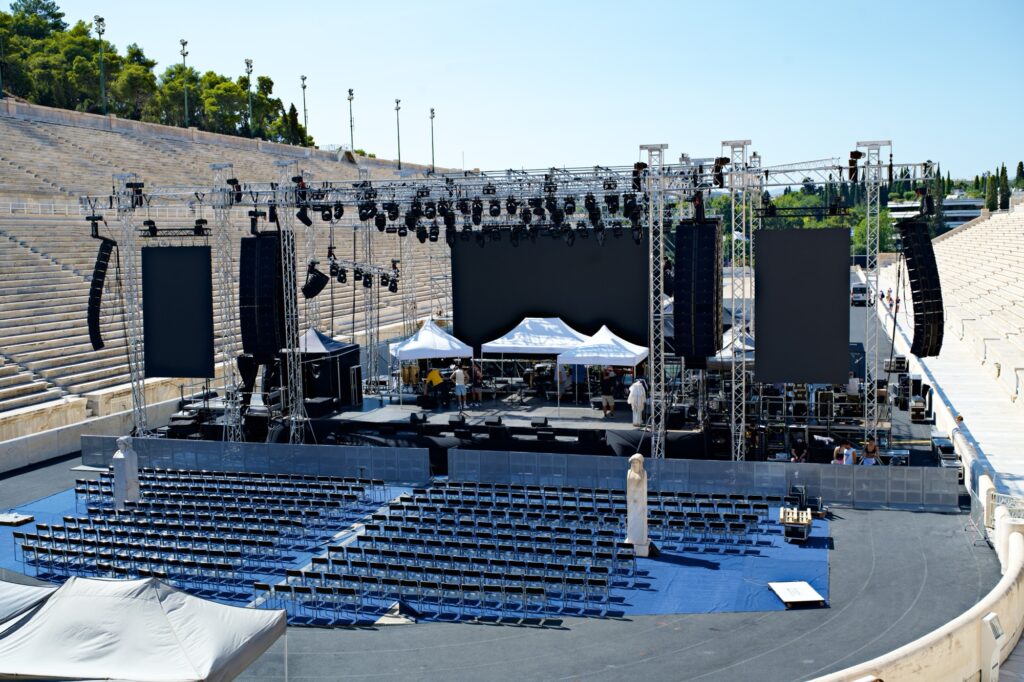
By the way, the track was closed as they were setting up for a Diana Ross concert the following evening. They were doing a sound check while we were there (without Diana Ross).
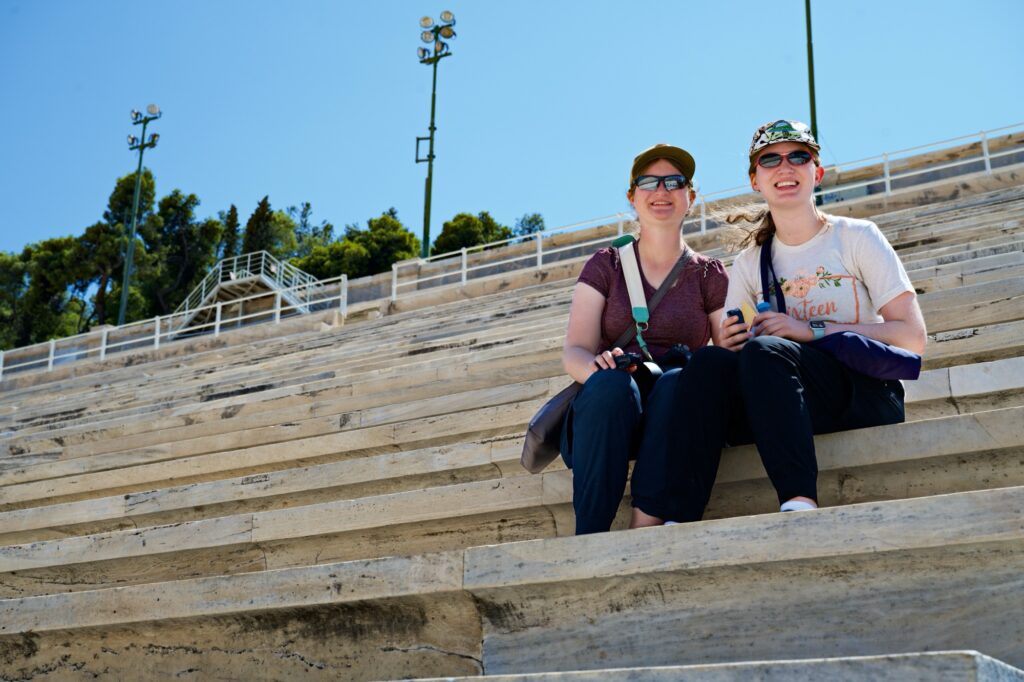
The original stadium at this site was built almost 2,000 years ago during the Roman Period, and was also built from marble. This original stadium was eventually abandoned in the fourth century after Constantine made Christianity the state religion.
The current stadium is an excavation, restoration, and rebuilding of the original for the 1896 revival of the Olympic Games. The original Olympic Games began in 776 BC, but were banned in the 4th century AD.
The stadium was only partially completed for the games in 1896 (many of the seats were made of wood), but construction continued at the conclusion. The stadium again hosted the Olympic Games in 1908.
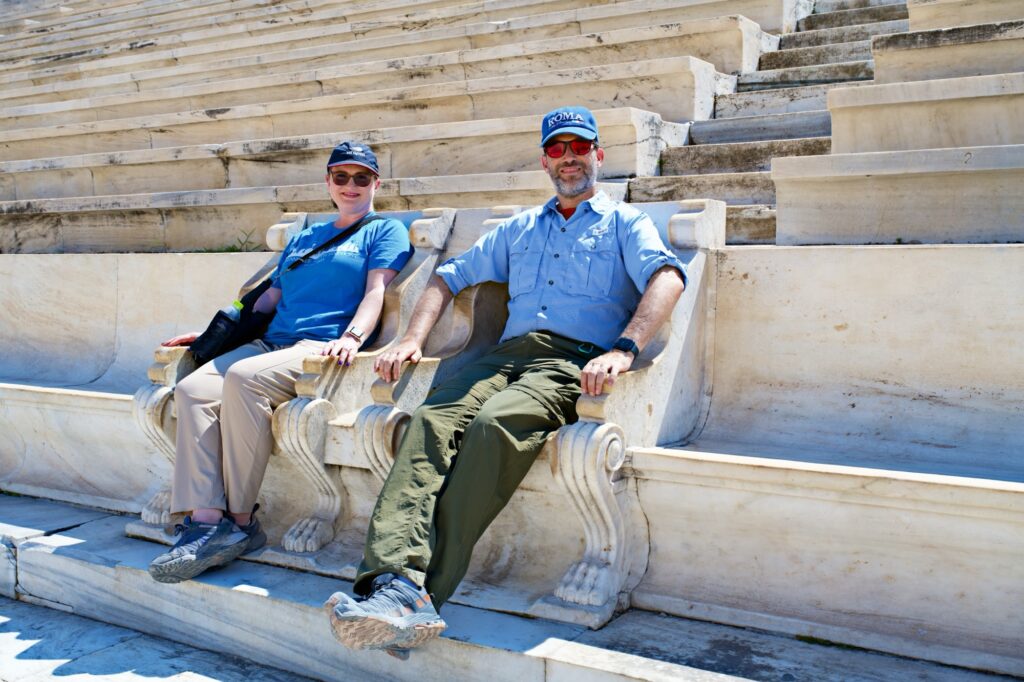
Walking along the seats, we saw two marble thrones surrounded by benches with backs in the middle of the side of the stadium (i.e. 50-yard-line). The two thrones were made for the King and Queen, and the benches for other important guests. This reminded me of the front row seats in the Greek Theatre of Delos and the Theatre of Dionysus at the Acropolis. These two thrones were not installed until the games of 1908.
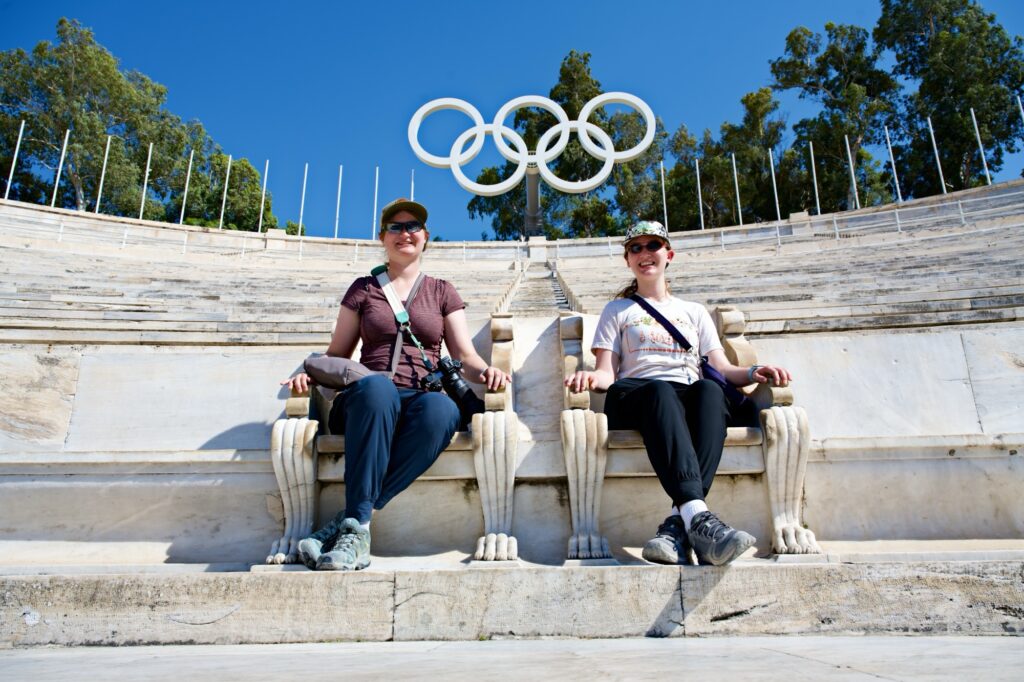
The original thrones for King George I and his wife Olga for the 1896 games were in the Sphendone, which is the curved section of the stadium. I took a picture of Kate and Sara sitting in these thrones with the Olympic rings over their shoulders. This is one of my favorites shots from the trip
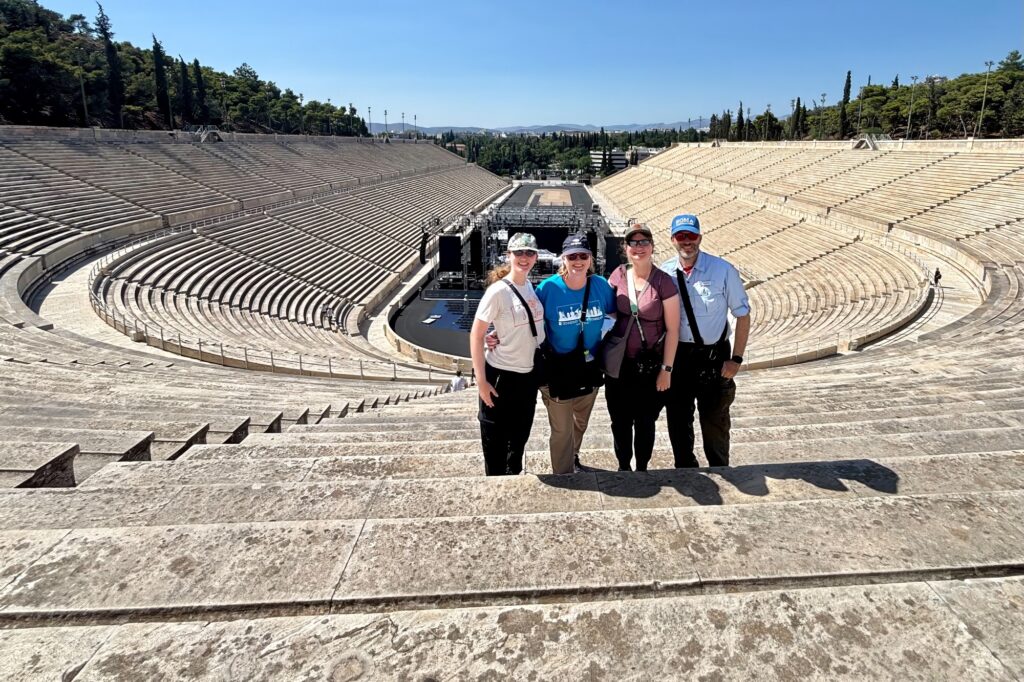
It was at this point that we climbed to the top of the stadium below the Olympic rings. Olivia was again a trooper as the steps are very steep in places.
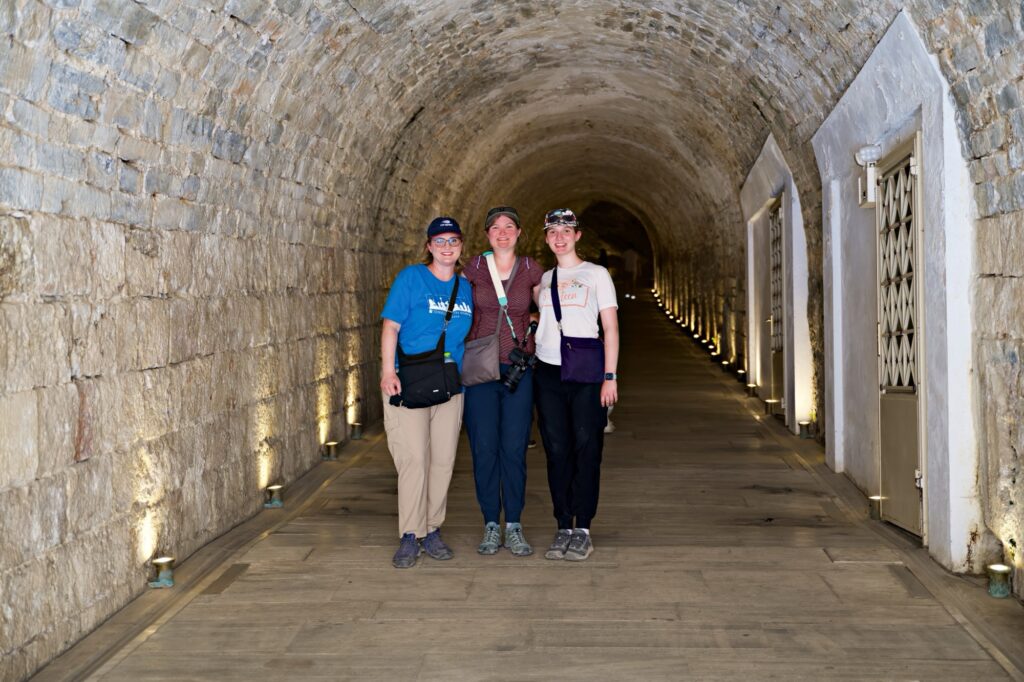
Once we came back down we went into the “Cave of the Muses”, which is just past the Sphendone. Over the centuries this tunnel has collapsed many times but has not been reinforced and js used to connect the dressing rooms to the stadium for visiting performers.

At the end of the tunnel is a room that contains many posters and torches from previous Olympic Games. I loved hearing Kate and Sara talk about which torch was their favorite. It was also neat to see the dates and locations from my lifetime and remember some of the big moments of those games. I love the Olympic Games!
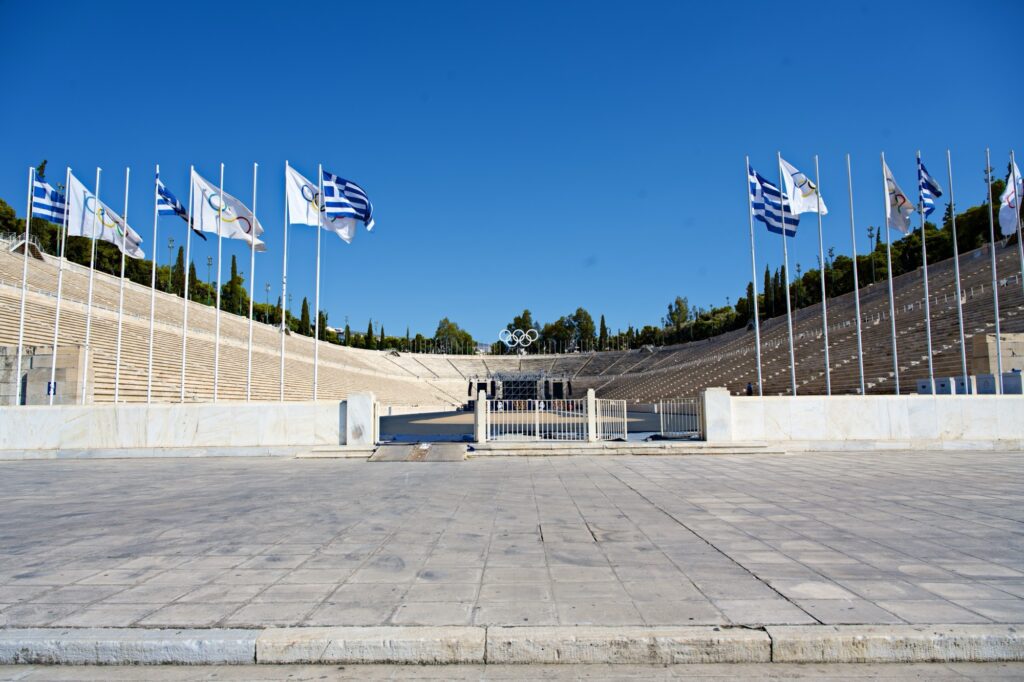
After we came out of the stadium, we bought some Powerade refuel and decided to try and squeeze in the Ancient Agora of Athens before grabbing dinner. The Ancient Agora is near our hotel, so we basically made a reverse course from our trip to the Panatheniac Stadium.
The Ancient Agora
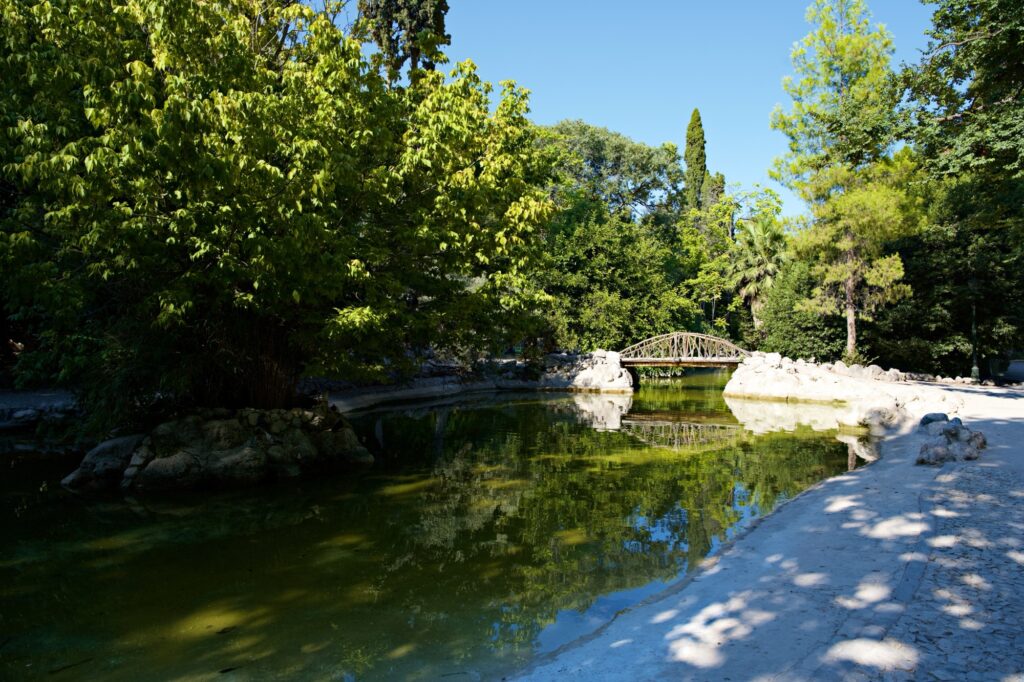
We again walked through the beautiful National Garden, taking a slightly different route than before.
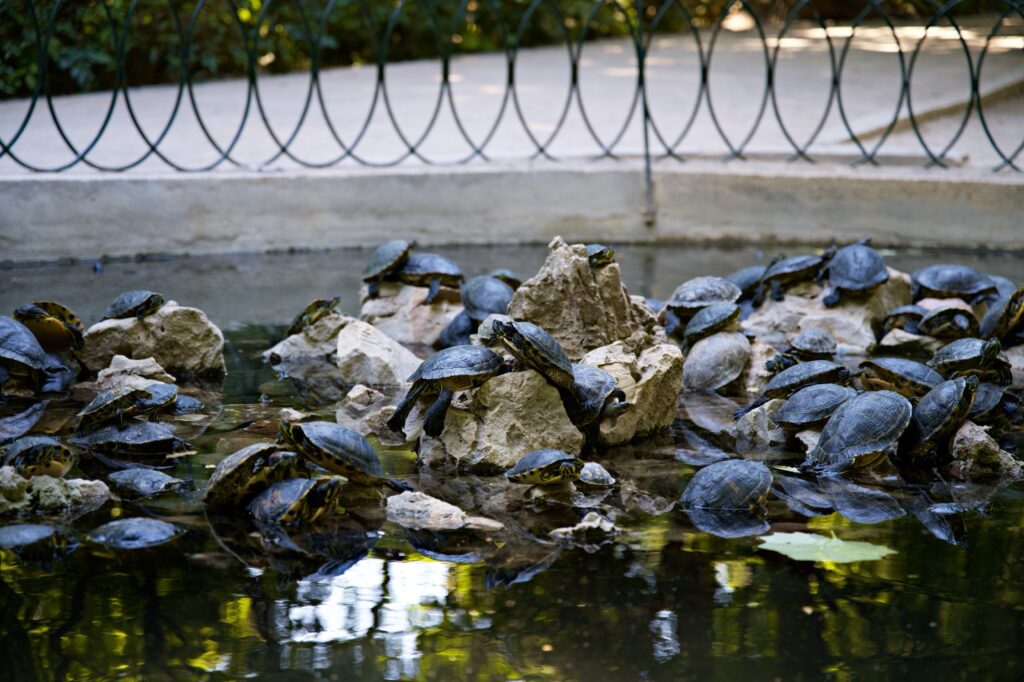
We made a quick stop by a lovely pond and found a turtle habitat nearby.
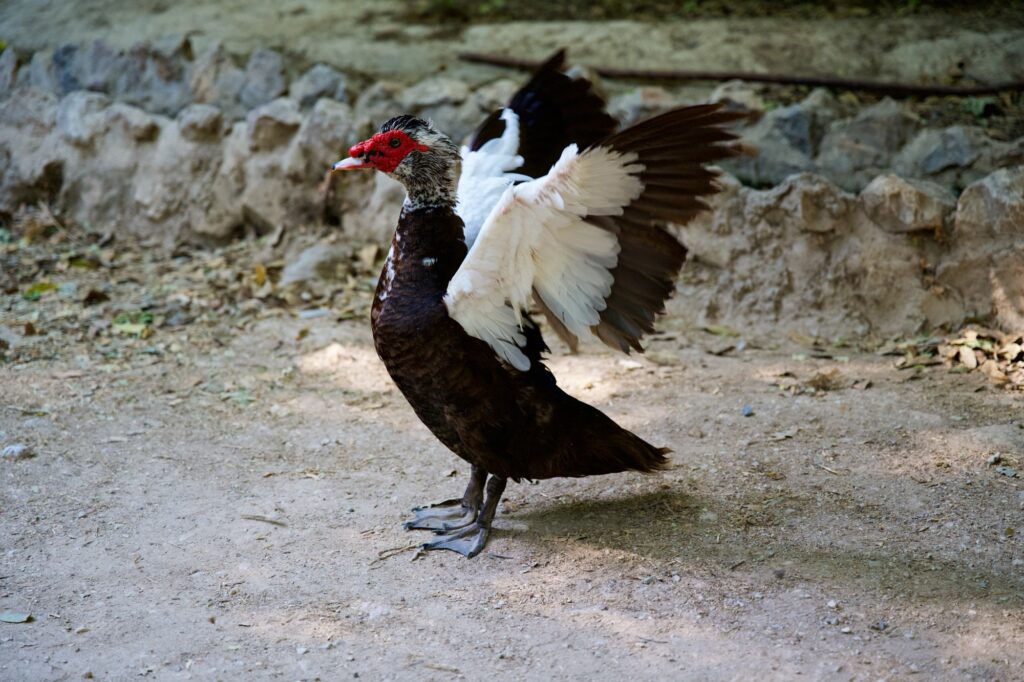
Also nearby was the largest duck I’ve ever seen. I think I referred to it as a “prehistoric duck” thinking it was like a duck dinosaur. It was not happy when I tried to get in close for a photo and started flapping its wings.
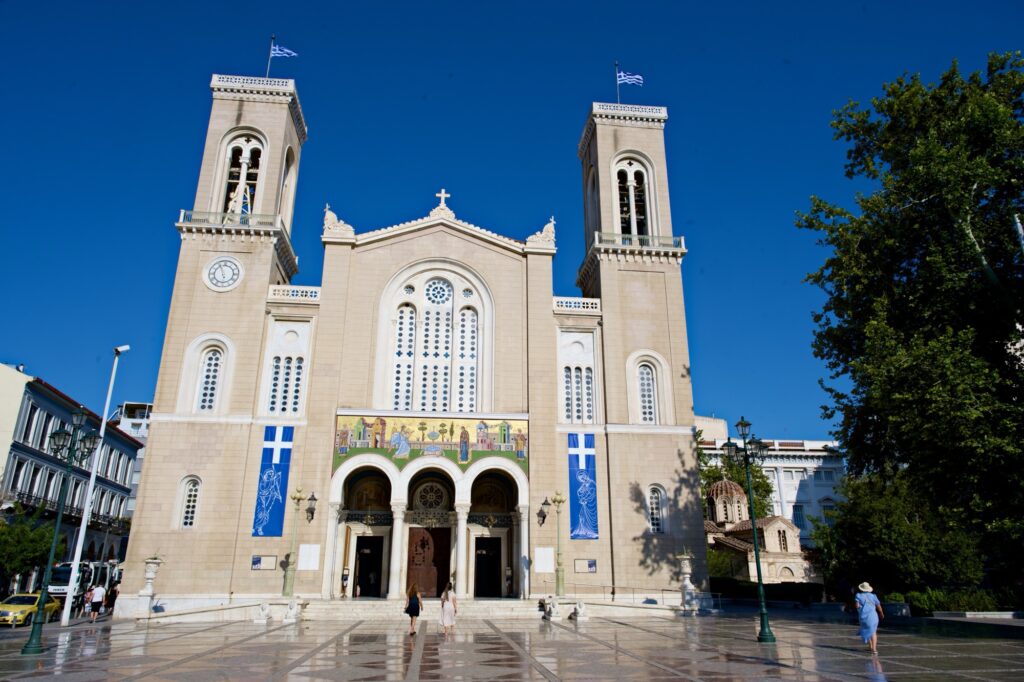
At Syntagama Square, we took a parallel street to Ermou (didn’t catch the name), and passed by the massive Metropolitan Cathedral of the Annunciation, built from 1842 to 1862. This is the “cathedral church” for the Archbishop of Athens and all of Greece. We didn’t go in, but I did snap a few shots as we walked around the structure.
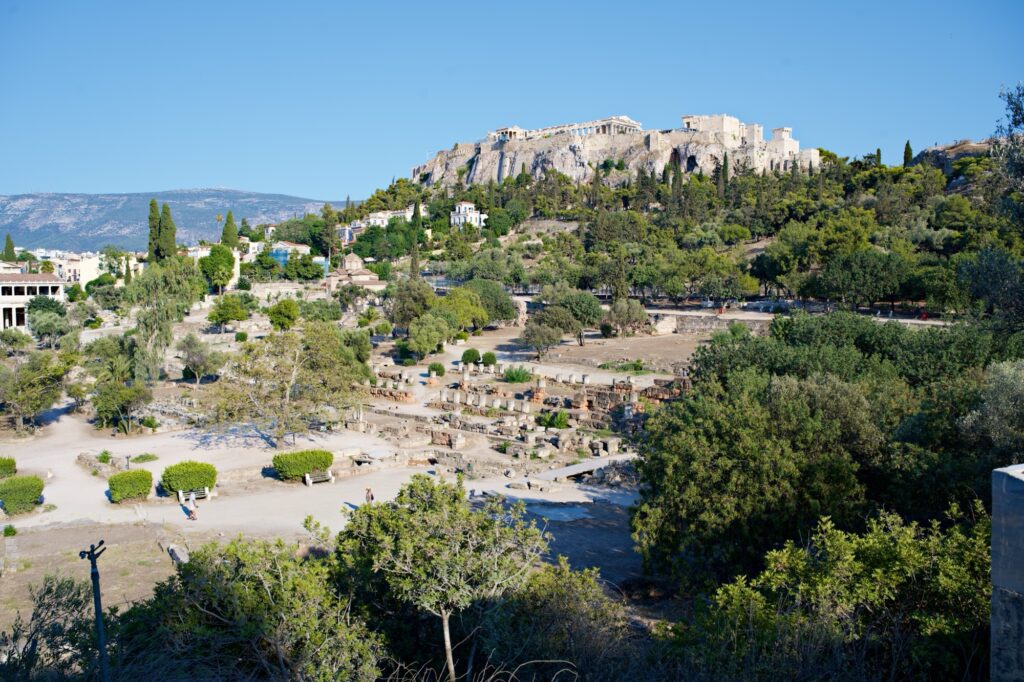
Once we reached Monastriaki Square, we decided to make a quick pit stop at our hotel. A few minutes later, we were back on our way to the Ancient Agora. GPS directed me to the entrance, but it was closed due to construction. We had a really hard time figuring out where the new entrance was located and ended up walking around almost the entire site, which is HUGE. I bet we walked over a mile trying to find the entrance. After finally getting our tickets, we only had about 40 minutes to explore before the site closed for the night at 7:30 PM.
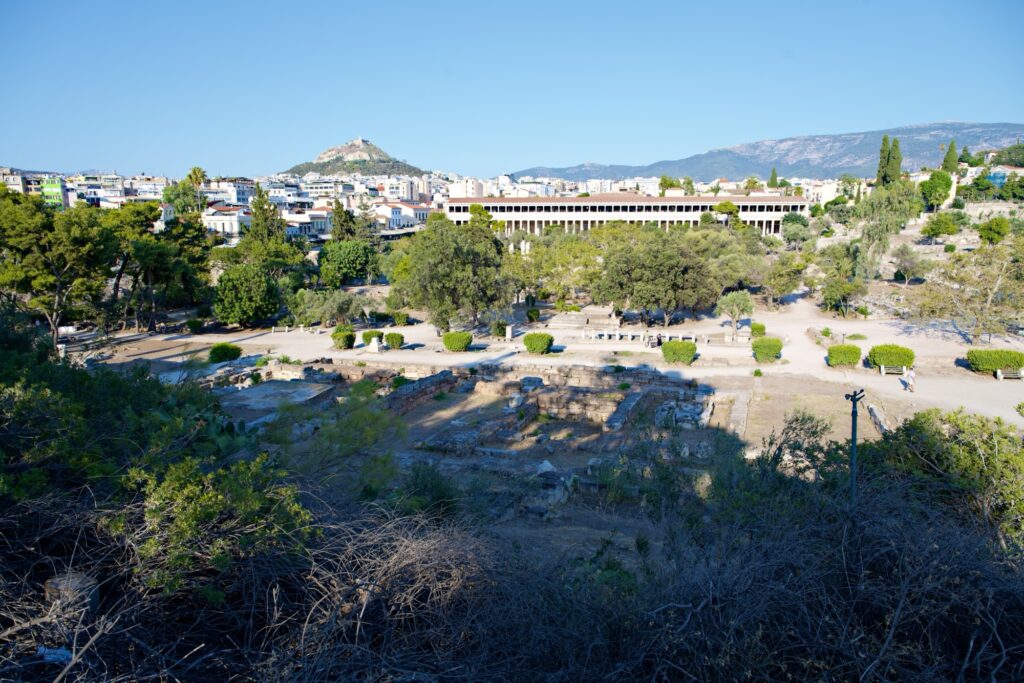
This site is called the “Ancient” Agora to distinguish it from the Roman Agora we visited yesterday. As I previously wrote, the Roman Agora replaced the Ancient Agora as the commercial center due to overcrowding from the construction of many large buildings in the Ancient Agora. However, prior to the Roman Agora, this was the public square, marketplace, and commercial center of Athens (It also included some houses as we saw on the southern end of the site).
As it relates to the Apostle Paul in Athens, Acts 17:17 tells us that he “reasoned…in the marketplace every day”. While I feel reasonably confident this would have been the Roman Agora, it is also possible it could have been the Ancient Agora (or both, since they were essentially connected).
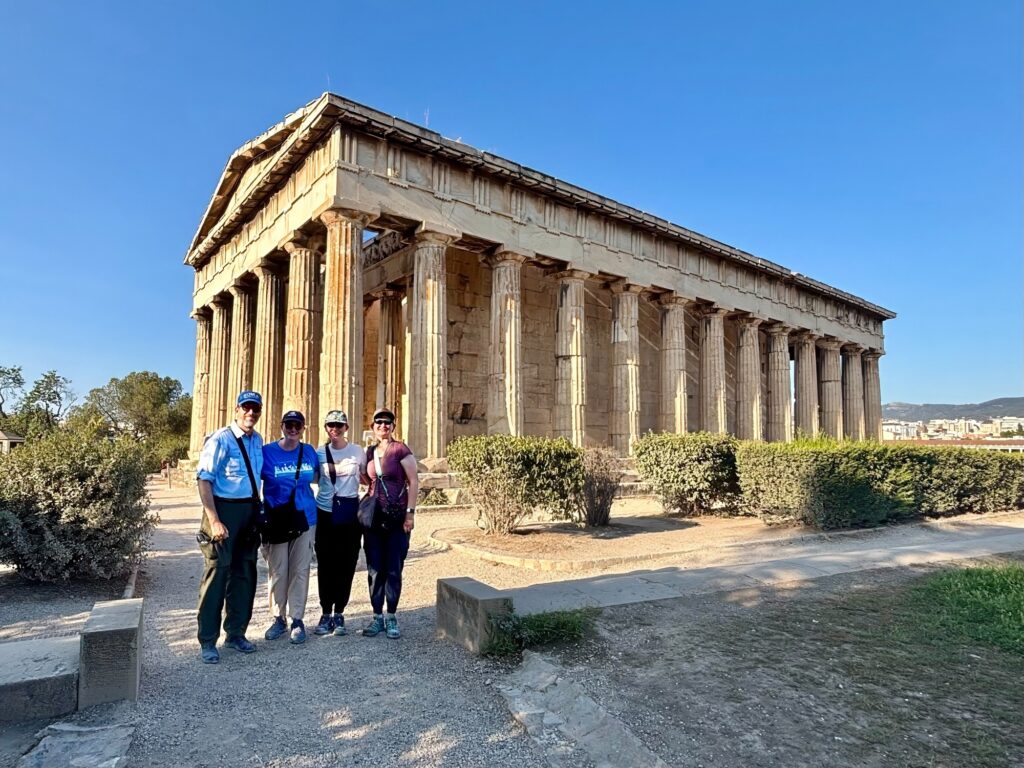
Our first stop in the Ancient Agora was the Temple of Hephaestus from the fifth century BC. This temple looks like a mini-Parthenon, and is incredibly intact. As a matter of fact, it is by far the most complete structure remaining in the Ancient Agora.
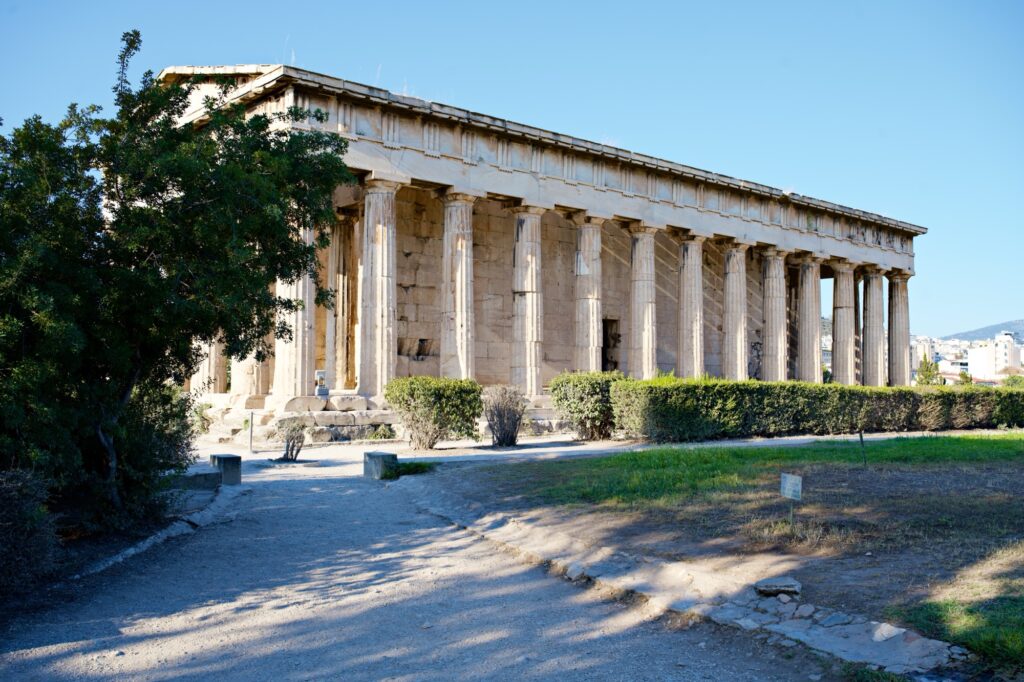
It was converted into a basilica in the seventh century AD that was used until 1834. This likely accounts for its incredible preservation. This temple really stood out while standing on the Acropolis yesterday, and I’m really glad we got to see it up close.
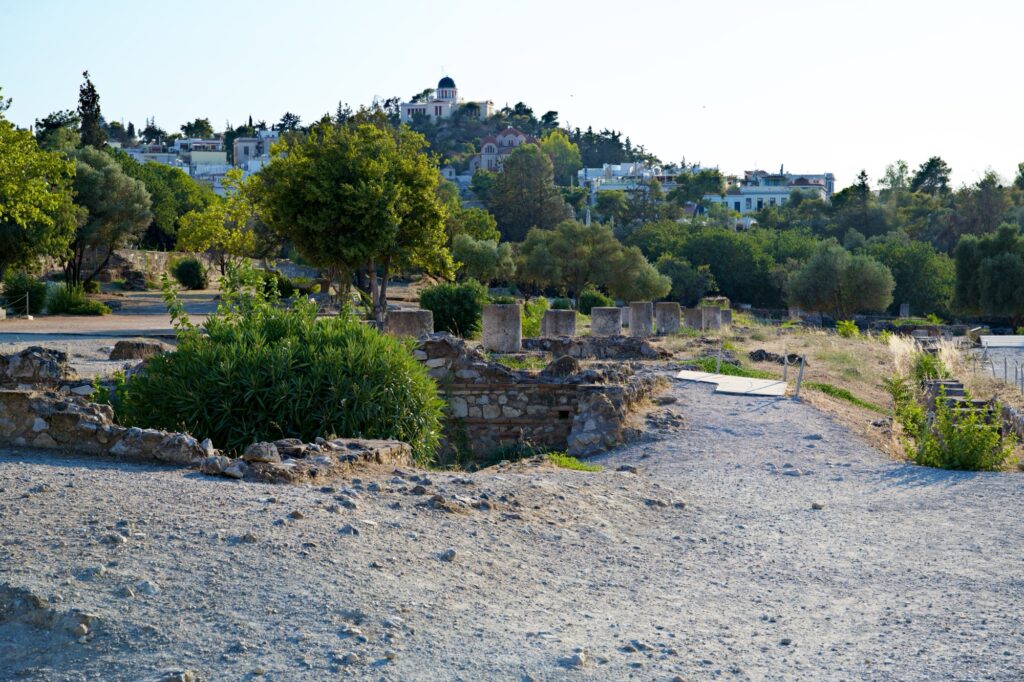
In the central part of the site, we saw the remains of many “stoa” or columned porticos throughout the Agora. The largest of these is now referred to as the “Middle Stoa” (it is in the middle of the site). These would have been used for public gatherings, shops, or offices.
We also saw the remains of the Odeon of Agrippa that was built around 15 BC. This was a two-story auditorium that seated around 1,000 people. It was a gift to the people of Athens by Marcus Vipsanius Agrippa, a Roman statesman and general.
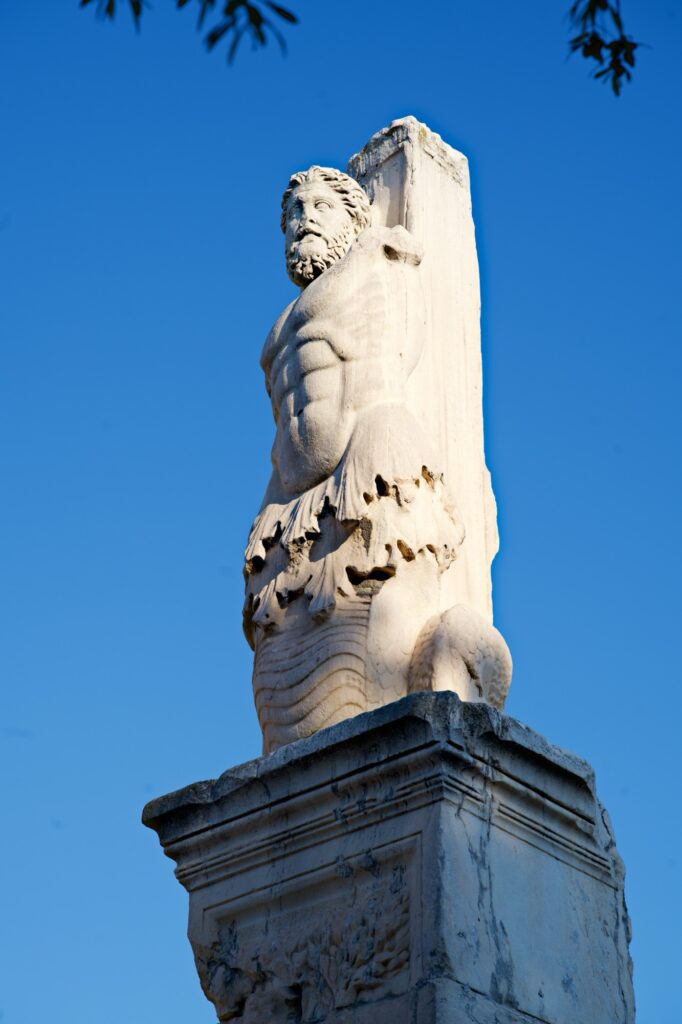
The original entrance was from the terrace of the Middle Stoa on the south side of the theater. After the roof collapsed in the mid second century AD, the entrance was rebuilt on the north side with massive pillars that were carved in the form of ‘giants’ (snake tails) and ‘tritons’ (fish tails).
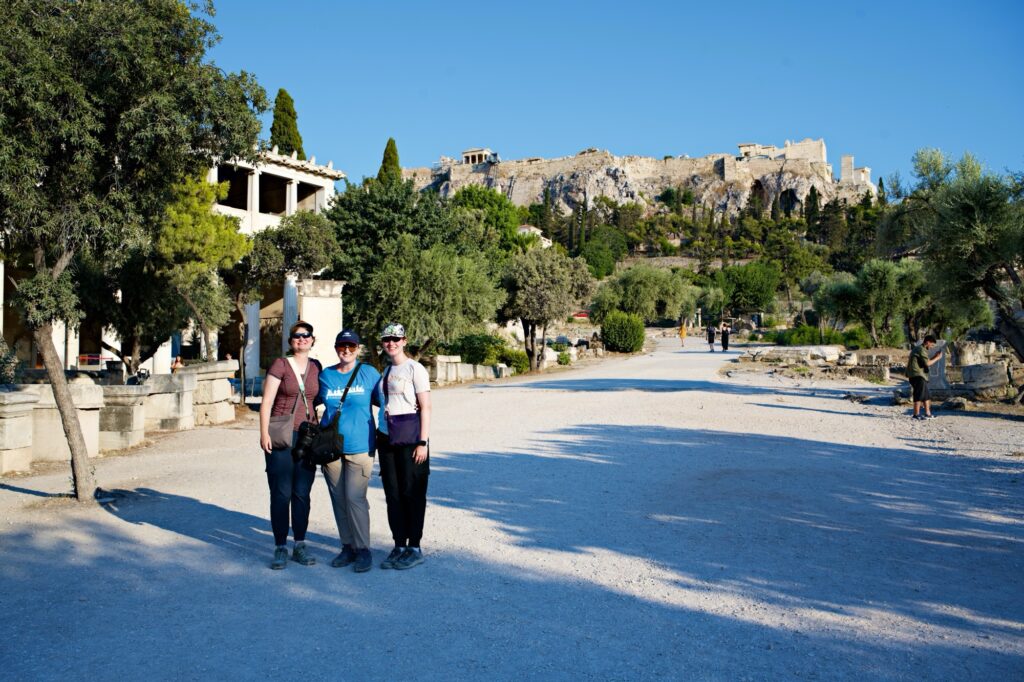
Finally, we walked down the Panathenaic Way, which was one of the most significant roads in Athens dating back to the sixth century BC. This road connected the Ancient Agora with the entrance to the Acropolis to the south.
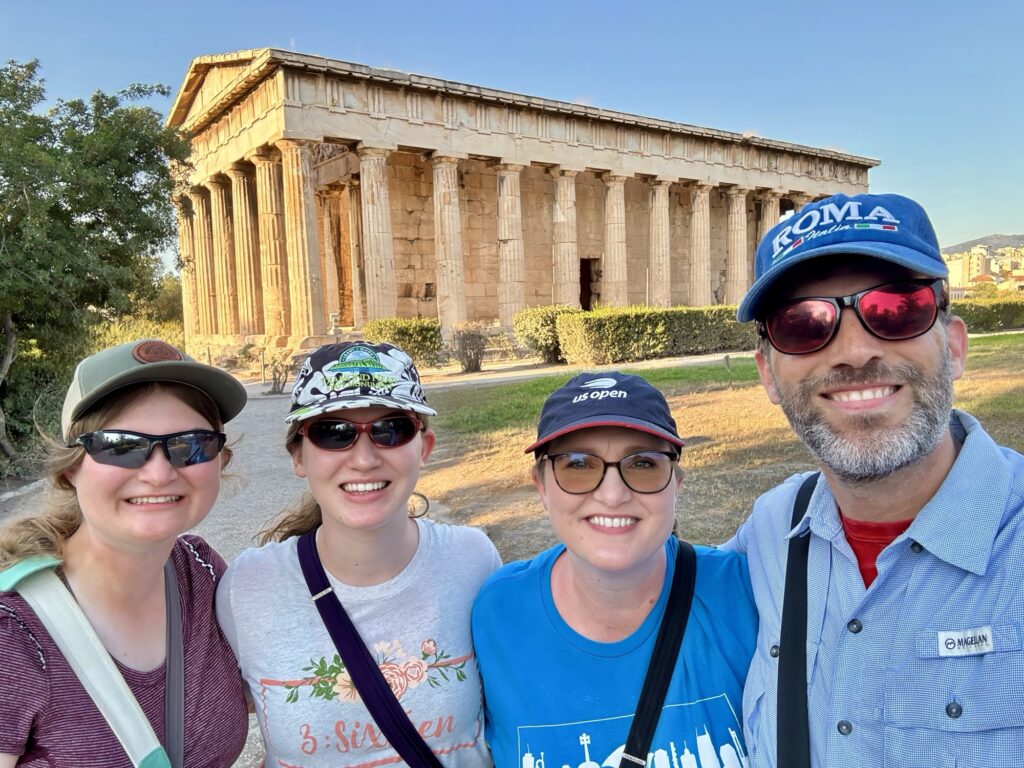
On our way out of the Ancient Agora, we made one more stop by the Temple of Hephaestus to take some photos before exiting.
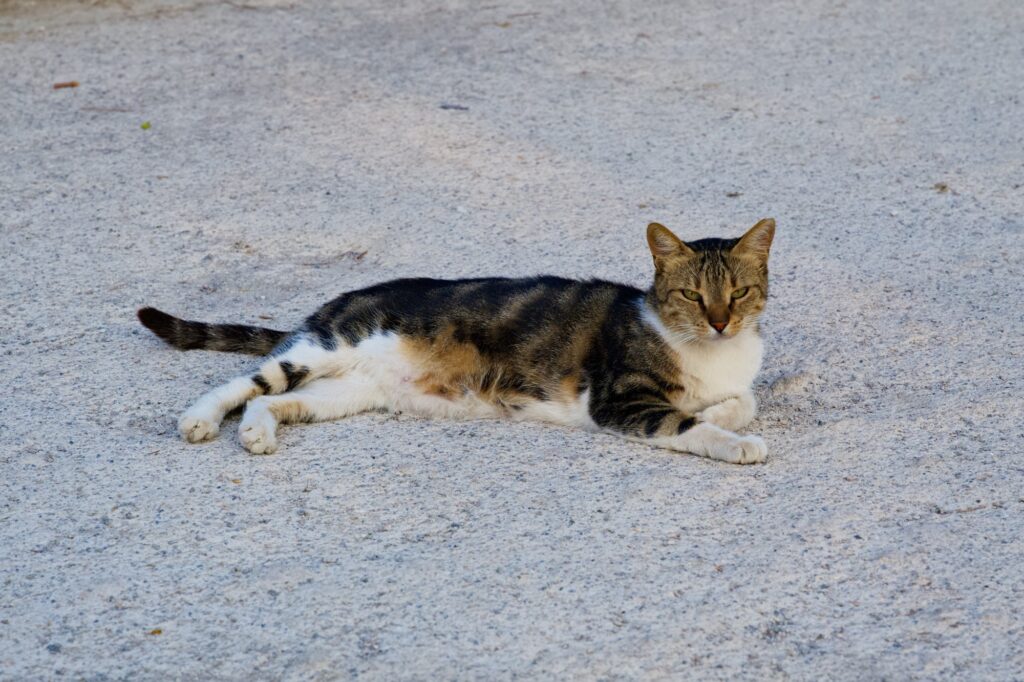
As we left the Ancient Agora, we spent a little time walking around Athens (even thought we were completely exhausted). We had seen feral cats all day long, but there was a spot near the Ancient Agora where there were so many cats that Olivia called it a “Free Kitty Zoo”.
Dinner
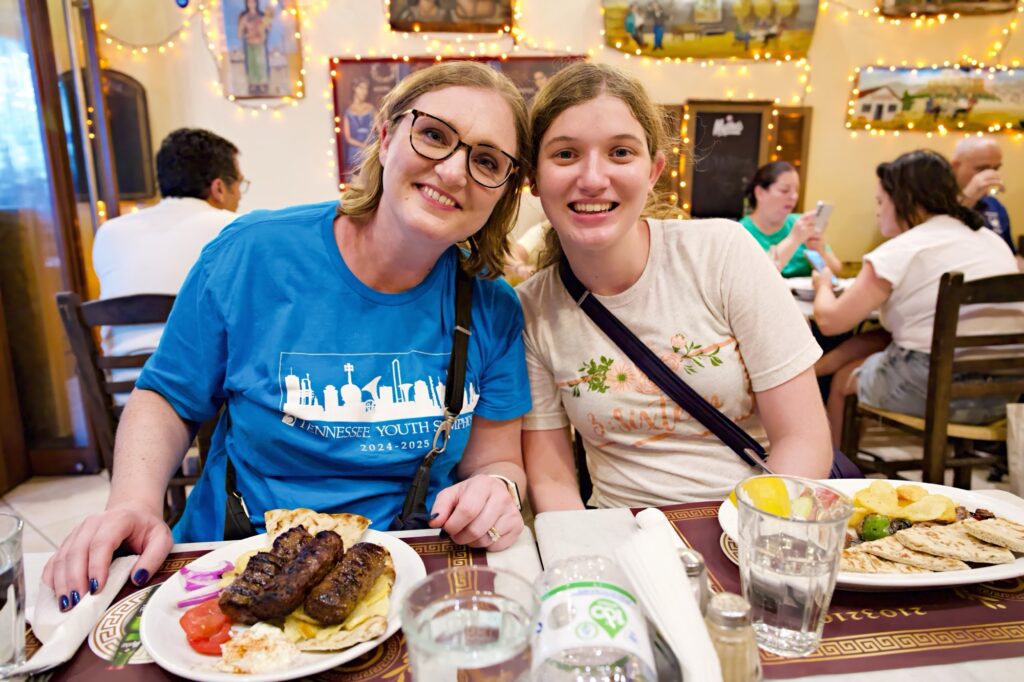
After our walk, we finally grabbed some dinner around 8:30 PM at a traditional Greek restaurant near Monastriaki Square called Maiandros. The food was great, but the atmosphere was chaotic. It was small, crowded, and it was hard to get anybody’s attention.
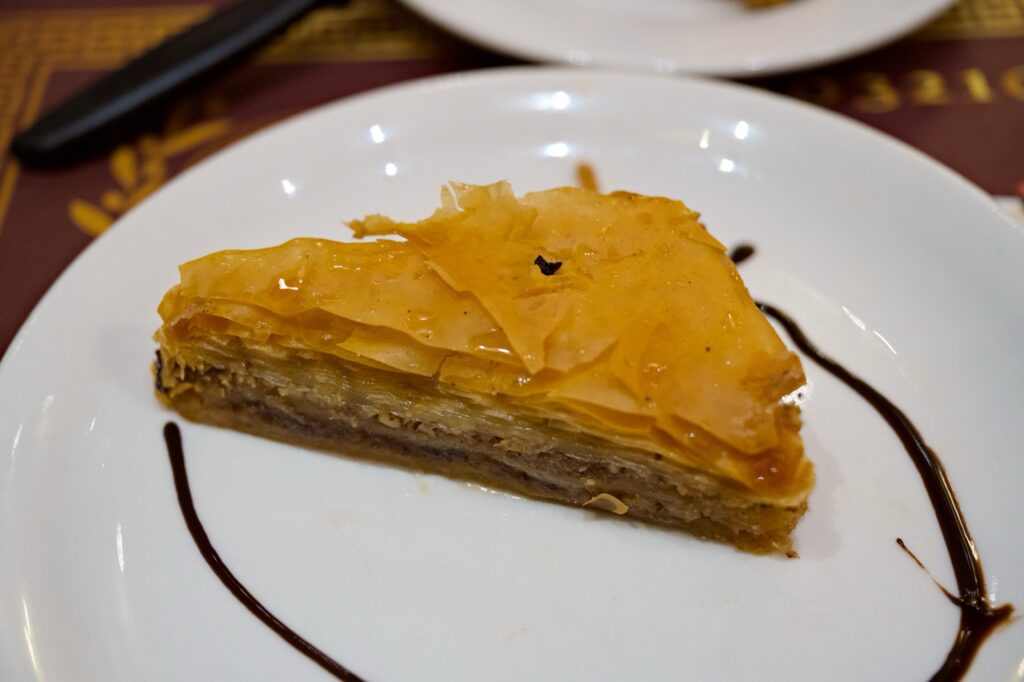
Regardless, the food was still fantastic. Olivia and I had kebab politiko, and Sara and Kate had pork souvlaki. For dessert, we again had some incredible baklava. The baklava is just ridiculously good.
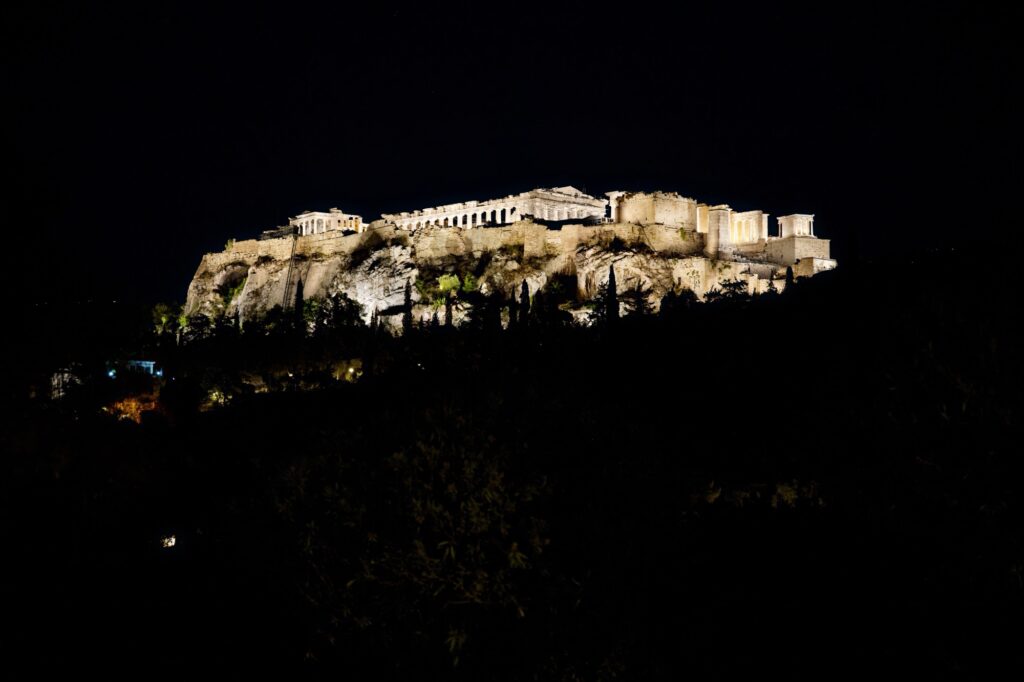
After dinner, it was quite dark, and we actually walked back to the entrance of the Ancient Agora. In all of our walking trying to find the entrance, I had noticed a spot with an amazing view of the Acropolis. Now that it was nighttime, we really wanted to see it all lit up. We were not disappointed!
We finally made it back to our hotel just after 10:00 PM having crammed more into one day than any other of the previous 12 days of our trip. Tomorrow we start the long journey home to Tennessee!
